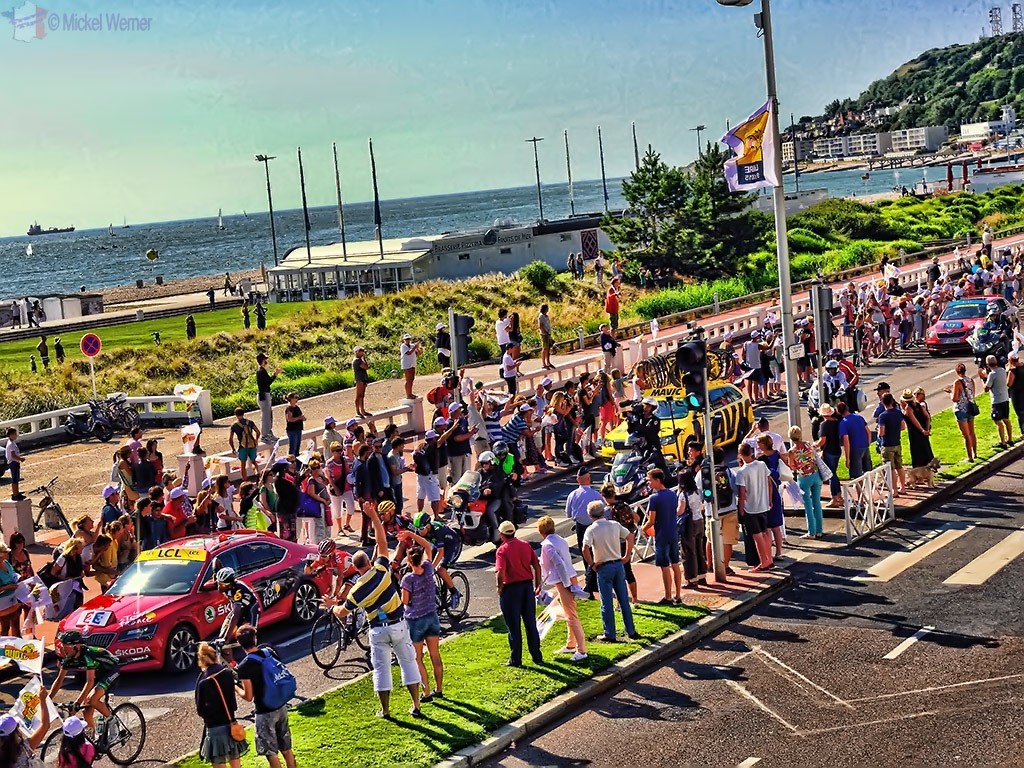The biggest single sports event in France, even in the word, is the prestigious bicycle race named the “Tour De France“. There are very few people who will not have heard of the “Tour”, even in the remotest villages in the world. Considered as the most prestigious bicycle race in the world, the Tour has been raced since 1903, and was created by a car magazine to increase their sales. Over the years the Tour has become the prime bicycle race in the world, a must on every cyclist’s agenda.
The Tour is transmitted on TVs around the world. On average, between 40 and 50 million viewers see the race on TV in their country. But it’s not only on TV that you can see the Tour. The Tour typically attracts millions of spectators alongside the road; not for the three week event, but PER DAY. That’s over 21 days, covering some 3500 kilometres.
Millions of spectators amass alongside the road having arrived there in their cars, motorcycles, caravans or camping cars. You will find the largest concentration of spectators on the hill or mountain climbs where cycling speeds are lower and you can clearly see the professional cyclists. And that is because in sharp contrast with the TV coverage, if you are standing alongside the road, the cyclists pass you by at a high speed (for bicycles), so within a minute or so, the race is over for you.
So why are there so many people willing to stand alongside the road for at least 5 hours so they can see the cyclists for one minute??? The answer lies below in 112 photos I’ve taken during the 2015 Tour de France (I took much, much more, but these are a few as appetiser) . Mind you, what you are about to see is a very small sample of what you get to see in real life. Because during a typical Tour day, some 3,000 vehicles will drive on the road you are watching. So if you don’t know whether you want to attend a Tour in “live”, here is what you can expect.
NOTE: Normally, all my articles are associated to a city/town, but this is not possible with the Tour since it takes different routes every year.
For your information, the day the Tour arrived in our city (Le Havre), it was targeted to arrive late afternoon. I’ve added the critical times to the list below so you can get an idea about waiting times. Fortunately, we did not need to wait out in the hot street, but could see the whole race from our elevated garden.
13:15

The first spectators started arriving, many well equipped for the event. The people who follow the Tour every year will come equipped with camping chairs, umbrellas, drinks and food. People will also bring musical instruments and other devices to keep themselves occupied.
13:30
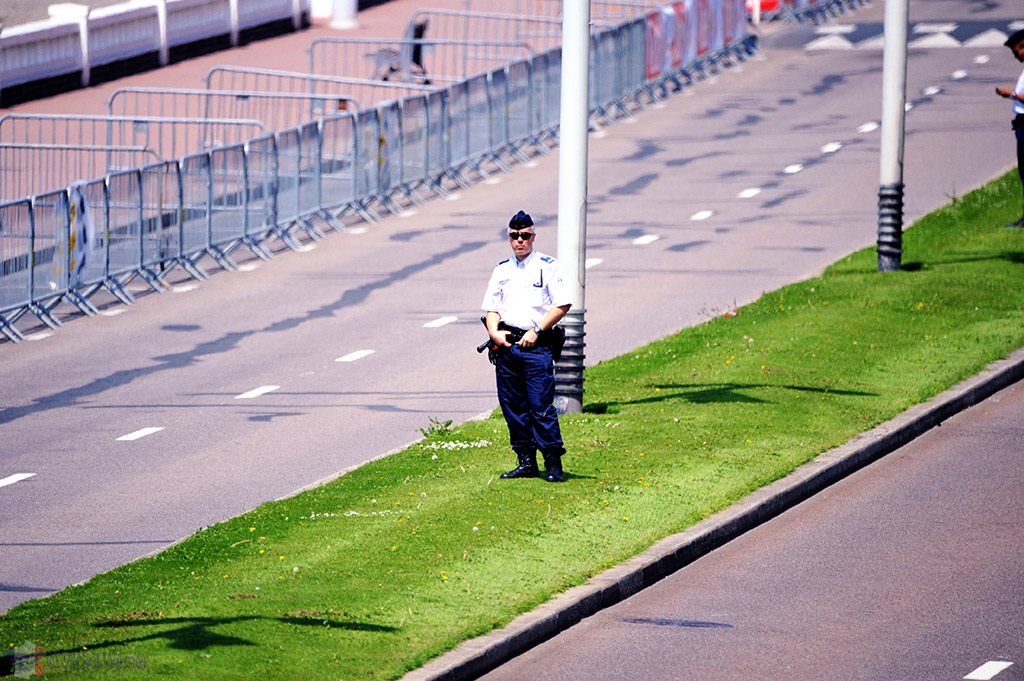
The first cops arrive on the scene. Literally every few hundred metres police were stationed to ensure the safety of the cyclists and of the spectators (and still most years there are accidents between cyclists and spectators). Most of the cops are on a rotation. After the race, they move to the next day’s race.
14:24

The first motorcycles carrying journalists arrive. They are often the broadcasters who are going to the finish line to wait for the race, or photographers staking out the best places for photos for when the race comes by.
But these journalists are not there for the main event, they are there to capture a pre-event, which you will see below around the 15:15 time mark.
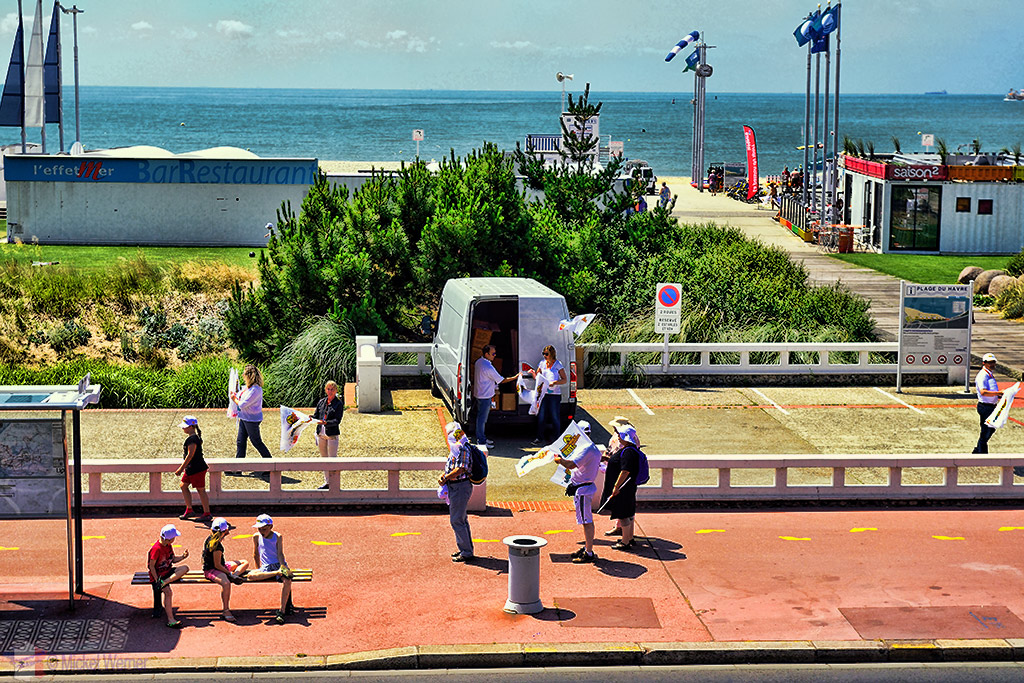
Souvenir-selling vans start arriving at the permanent places, in contrast with vans who move around. This van is from the local region (Seine-Maritieme) handing out free banners and flags.
14:38

The first cyclists arrive!! But they are not professionals, nor do they have anything to do officially with the Tour. They are amateur or tourist cyclists who ride the Tour’s itinerary, but start 5 hours before the actual race. Because the roads on which the Tour will pass are closed for all car traffic at least 5 hours before the race. So these cyclists can cycle the whole Tour in safety without the risk of being run down by traffic.
Can you imagine going home and bragging that you “did” the Tour de France???
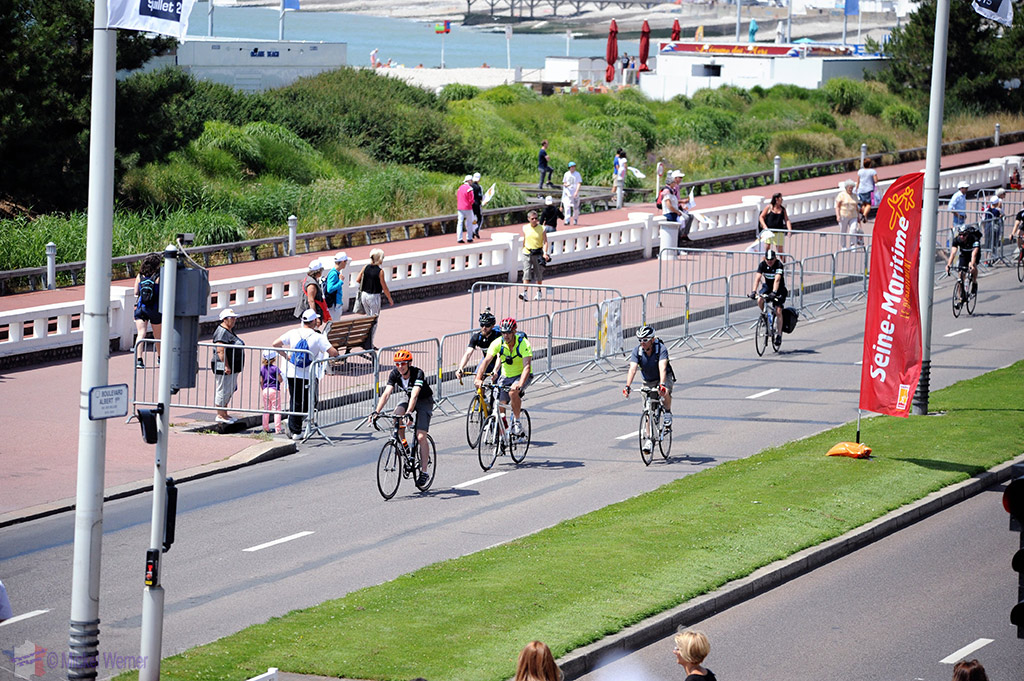
Several of these cyclist groups seem to be in organised tours. Cars bring their luggage to the starting point of the next day, allowing them to cycle lite.
14:46
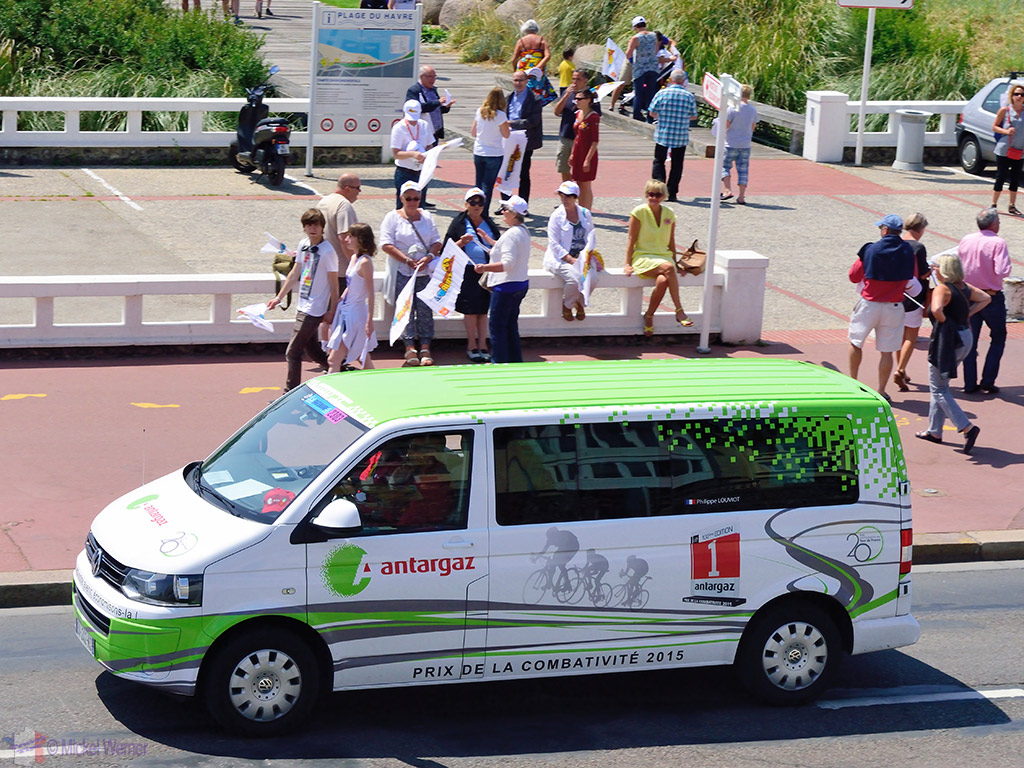
The first cars and vans carrying the sponsors and their VIPs arrive on the scene. They are all heading for the VIP areas where they will be wined, dined and entertained until the cyclists arrive. There will be many of these coming through.

The first commercial vans arrive, selling (some giving away) items like water.
15:15

The first motorcycle Gendarmes arrive with strobe lights and sirens, heralding the arrival of “something”. There are about 50 of these motorcycle cops in the Tour, many belonging to the elite “Garde Republicaine” (the unit that escorts heads of state).
The cops have a leap-frogging system in place. One cop rides up to intersections or roundabouts, warning cyclists of imminent dangers, and when the last cyclist has passed they jump on their motorcycle and race to the front and wait inline with the other cops for the next stop point. This allows them to guard danger areas over the length of the day’s race without having 100’s of motorcycle cops.
And the reason they (and the photographers) are there…

… because the “junior” Tour de France is arriving.
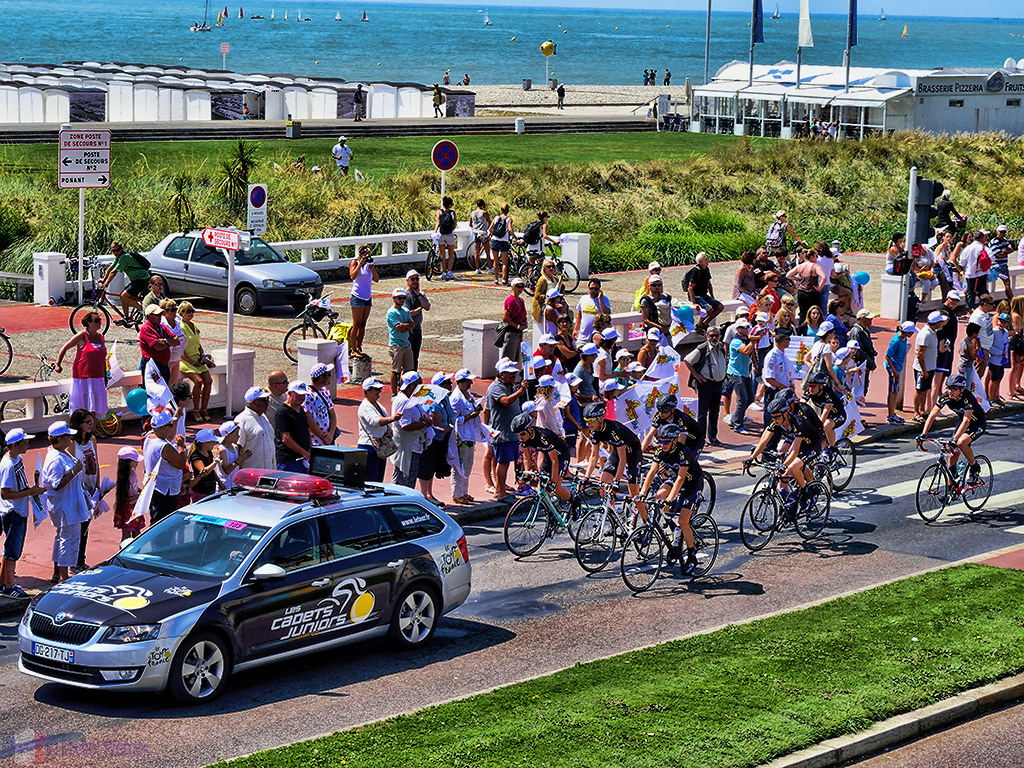
It’s a much smaller group of young cyclists (<18 years) who are preparing to move to a professional career of Tour de France cyclists but have not reached the right age.
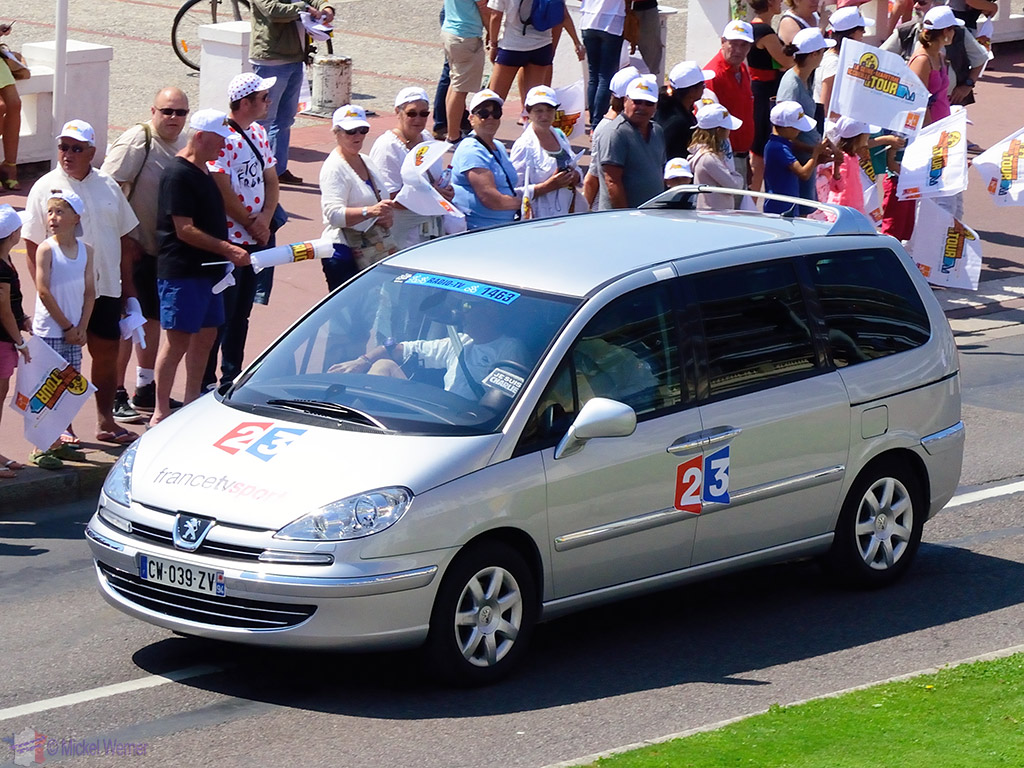
The small cyclist group is followed by several vans, including the French national TV channel (A2 and A3 channels) van, who also happens to be one of the main sponsors.
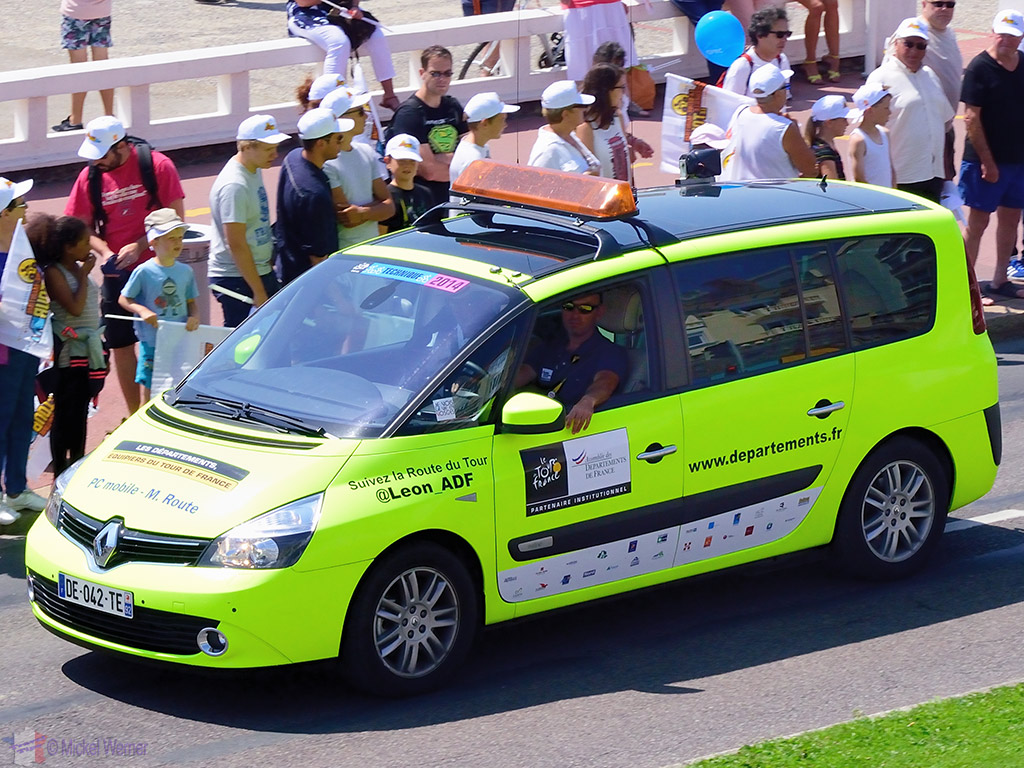
One of several SUVs carrying technical and support staff.
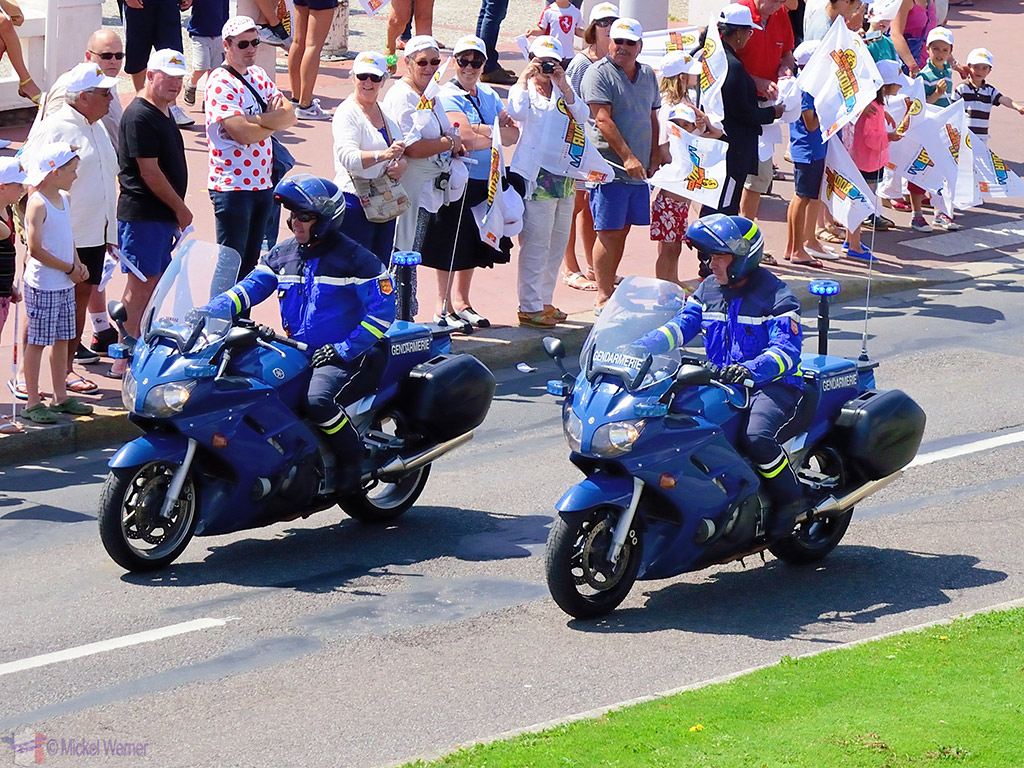
We’ll be seeing more and more police officers, mostly on motorcycles, passing by.
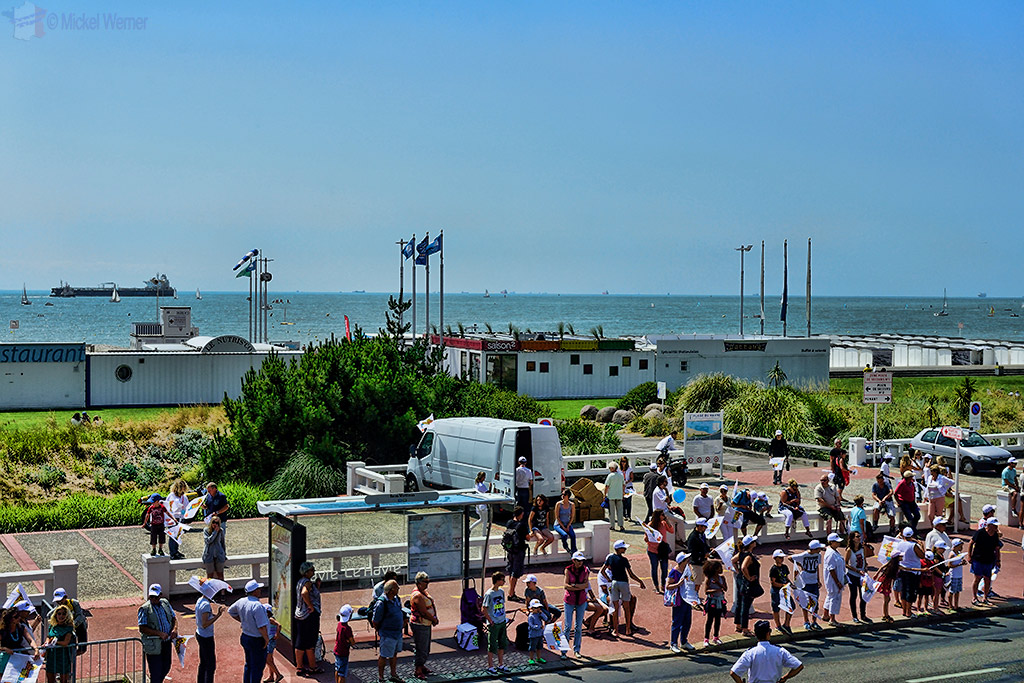
More and more spectators start arriving, many still trying to get the best positions, but most are already gone to the early birds.

The first cars belonging to the radio stations start arriving. This is the France Inter radio station.

This is the RTL radio car, featuring Laurent Jalabert, a famous French cyclist, as presenter.
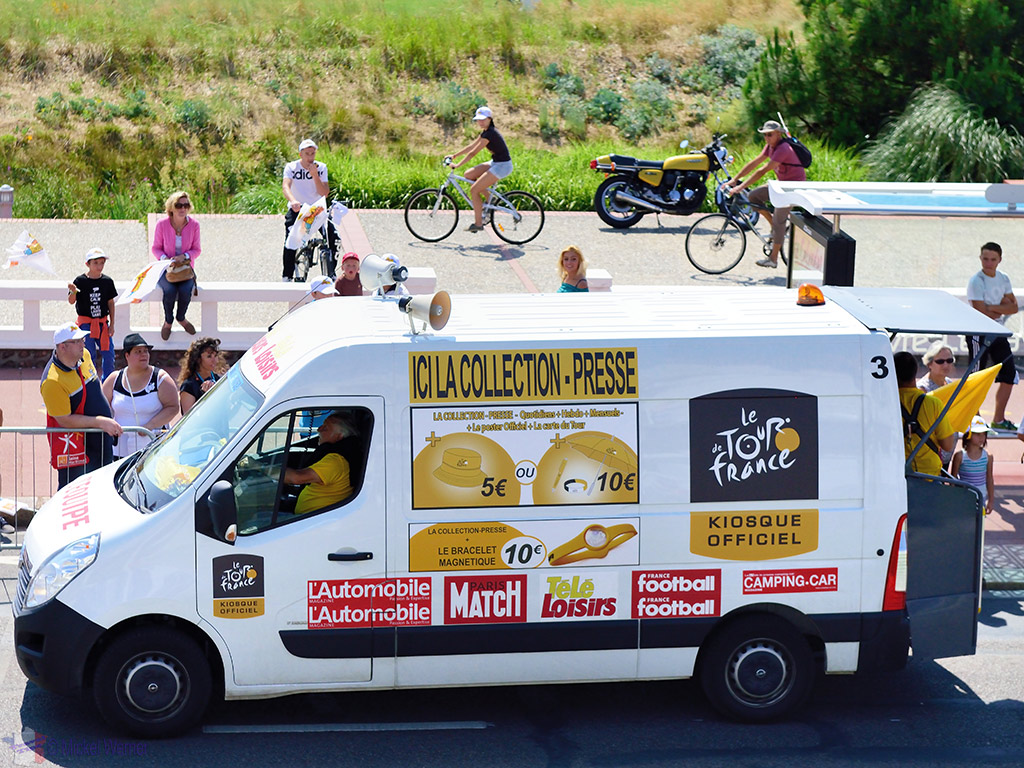
The first van selling souvenirs of the Tour de France. At the back of the van are the sales people selling t-shirts, hats, watches, all stamped with the Tour de France logo.
You’ll notice the sales folks are harnessed into the van. All people in the vans and upcoming trucks & rolling displays are fitted with an harness for safety reasons.

More and more sponsors and VIP transport arrive. Usually, at least once during the race, one of these cars will be transporting the President of France.
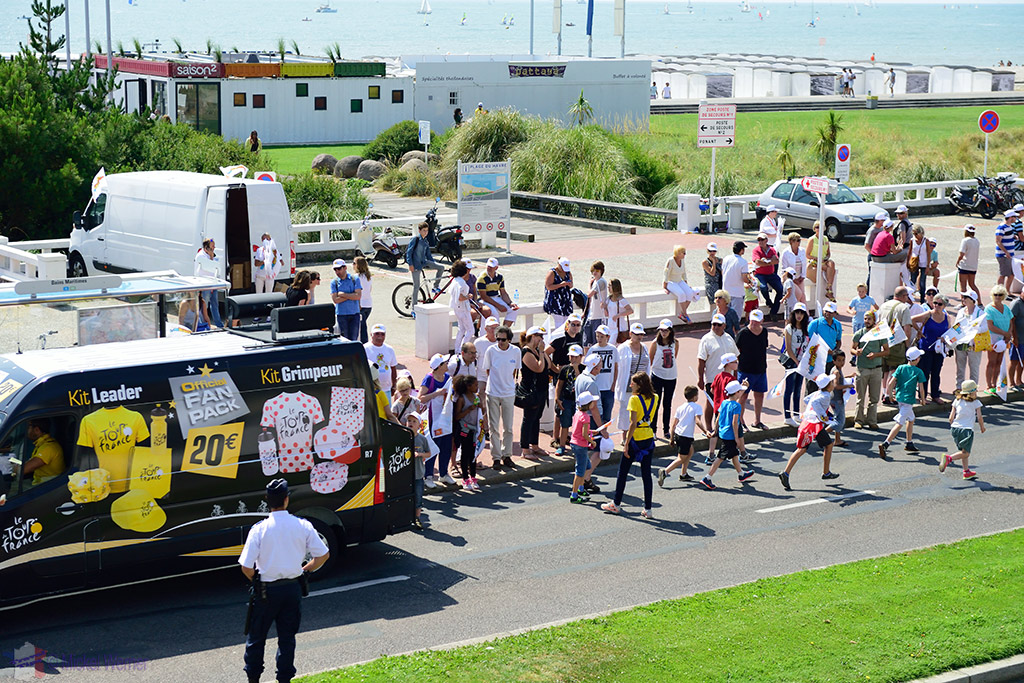
More and more souvenir-selling vans arrive. Their sales people get out and approach the public trying to convince them to buy their kits.

Notice the harness.
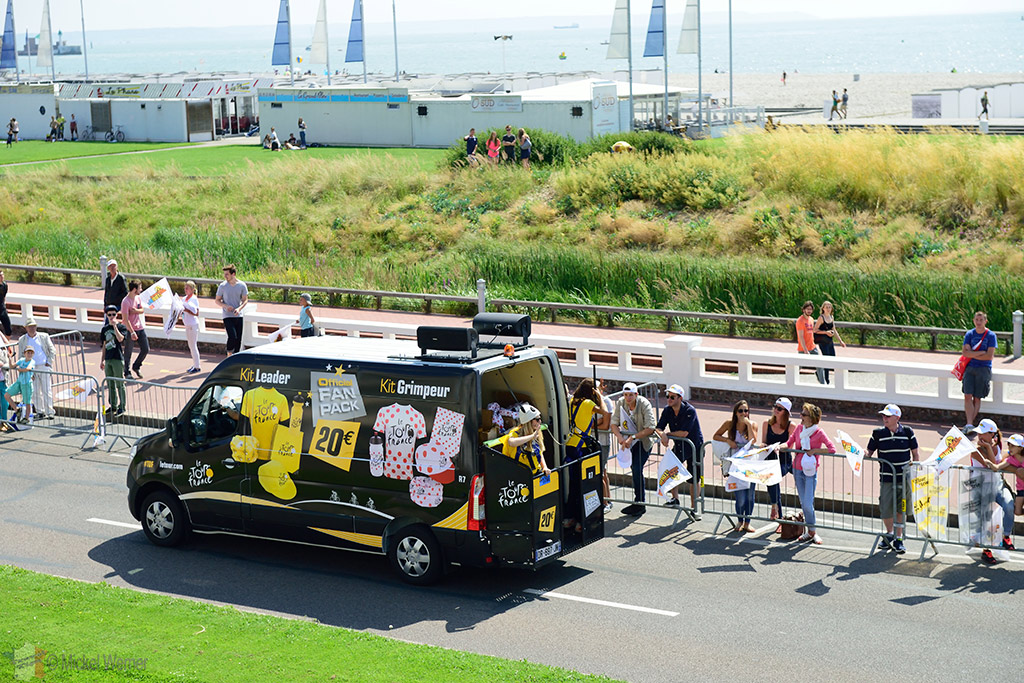
Here you can see the staff hooked into their harness in the back of the van.
16:22
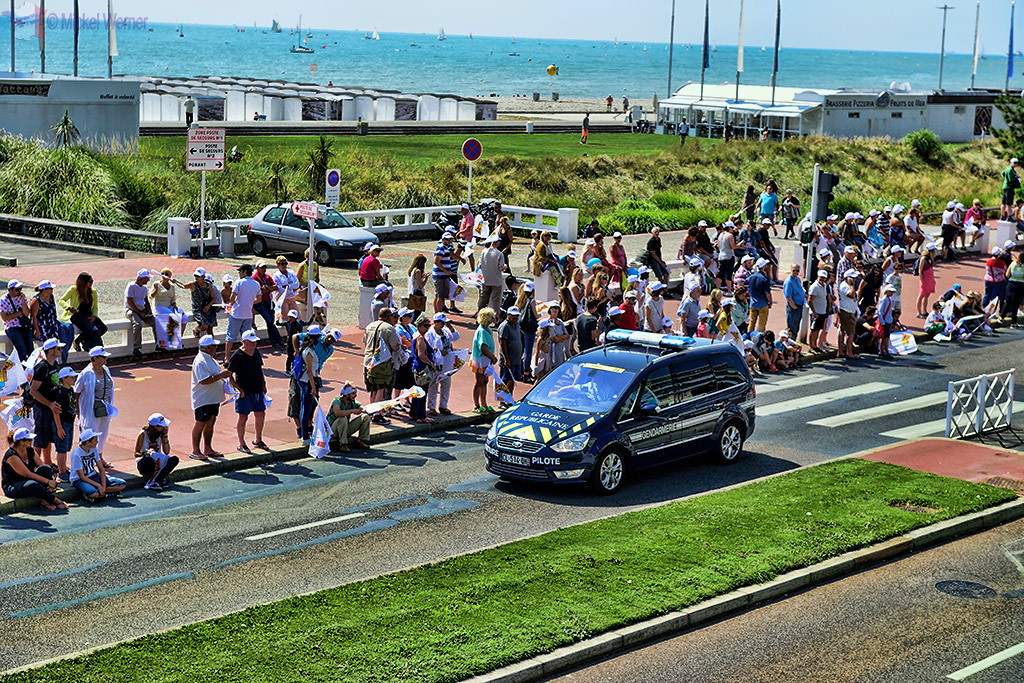
The car belong to the Garde Republicaine arrives with flashing strobes and sirens, signalling that something is up.
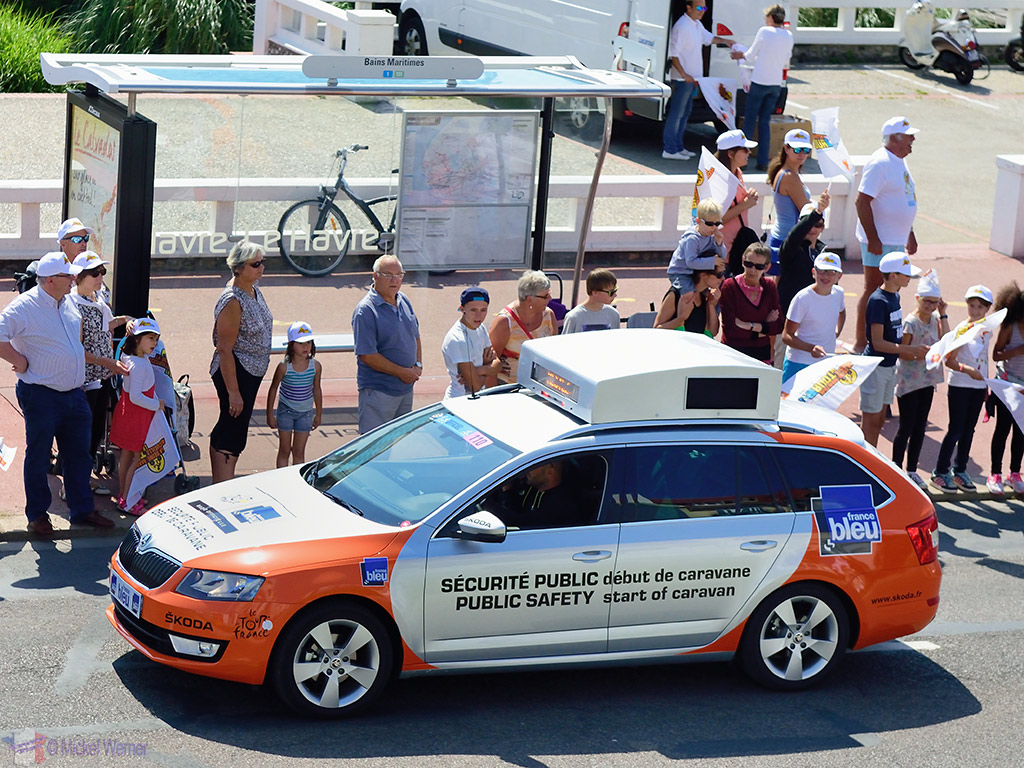
Followed by the public safety car, with loudspeakers telling people to stay clear of the upcoming vehicles and to make sure their kids are safe.
And the reason for this, is the reason why most people are here…. for the publicity caravan. 47% of the spectators come for the publicity caravan, not for the race. And that is because they will be getting free gifts.
There are some 160 vehicles representing about 40 brands. 600 people in these special vehicles will be handing out 14 MILLION items to the public.
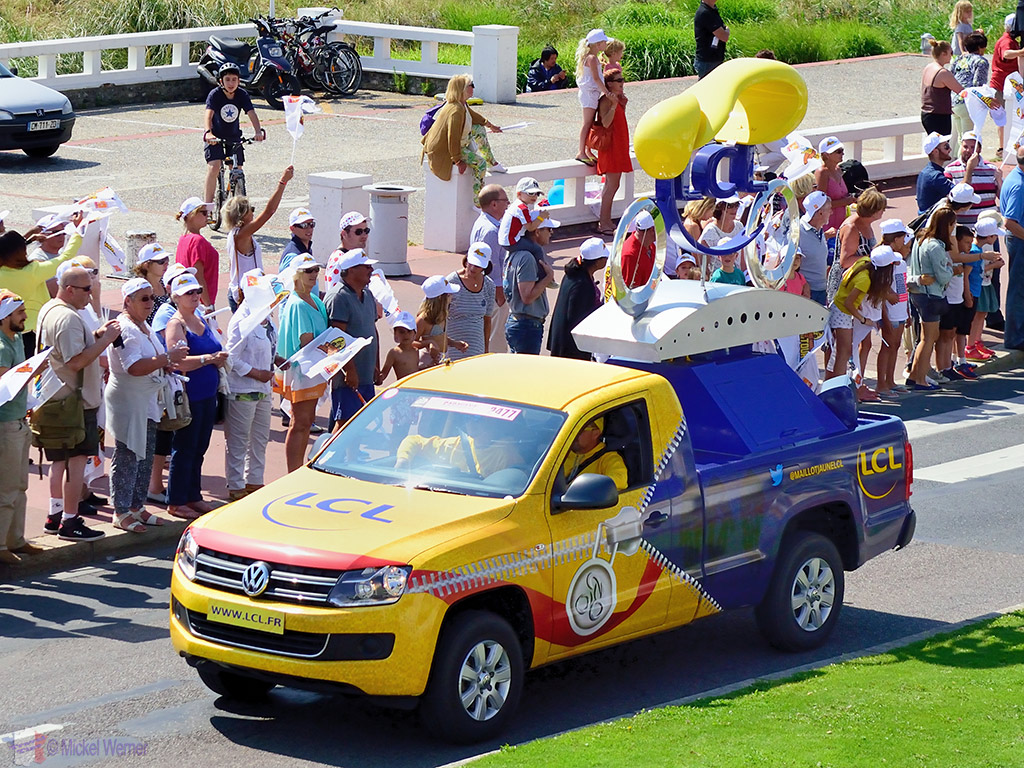
The first vehicles arrives (LCL bank). The whole procession will last 35 minutes and is 12 kilometres long.
And there are many vehicles, many very special ones. Here is a long list of some of them:

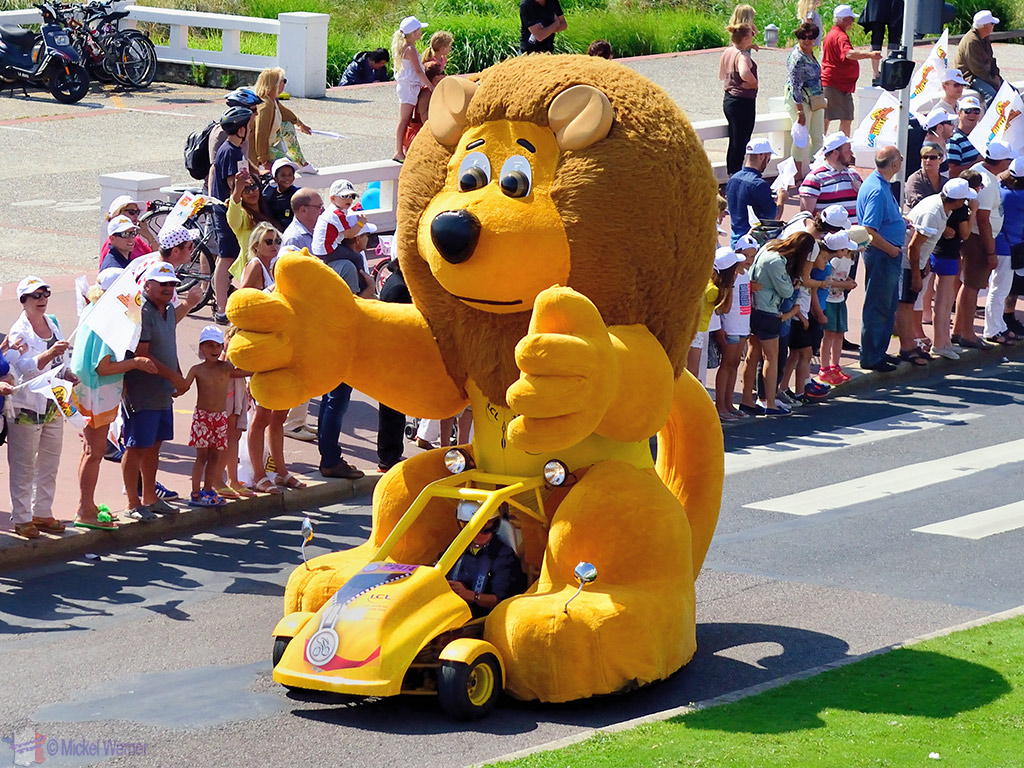
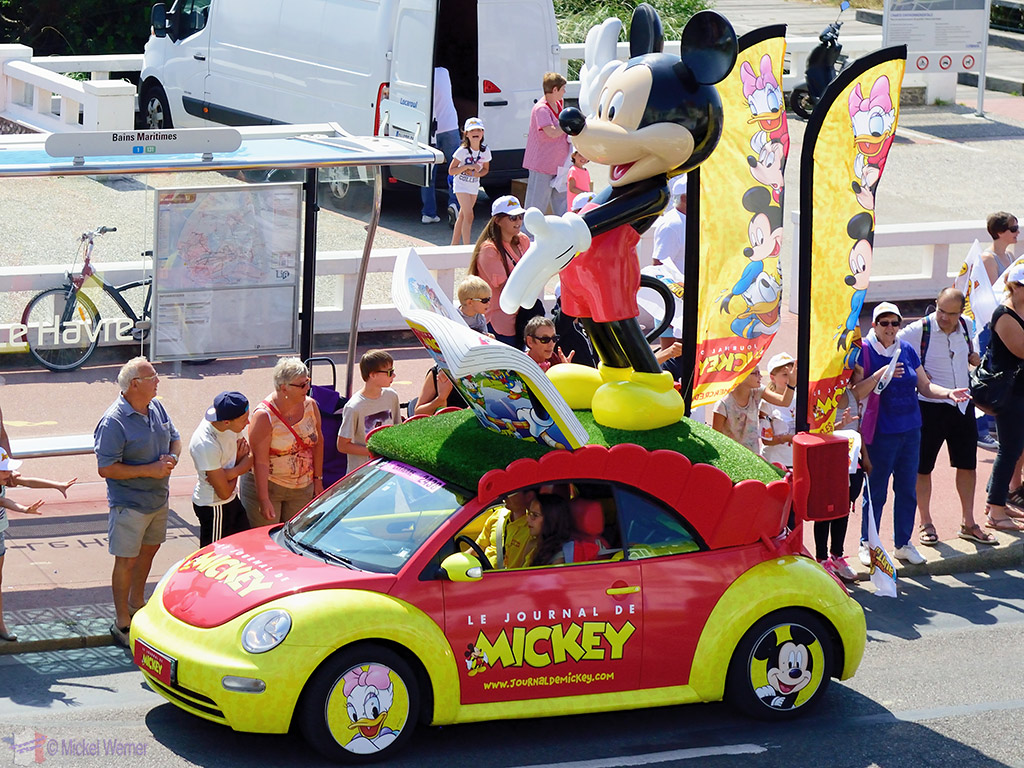
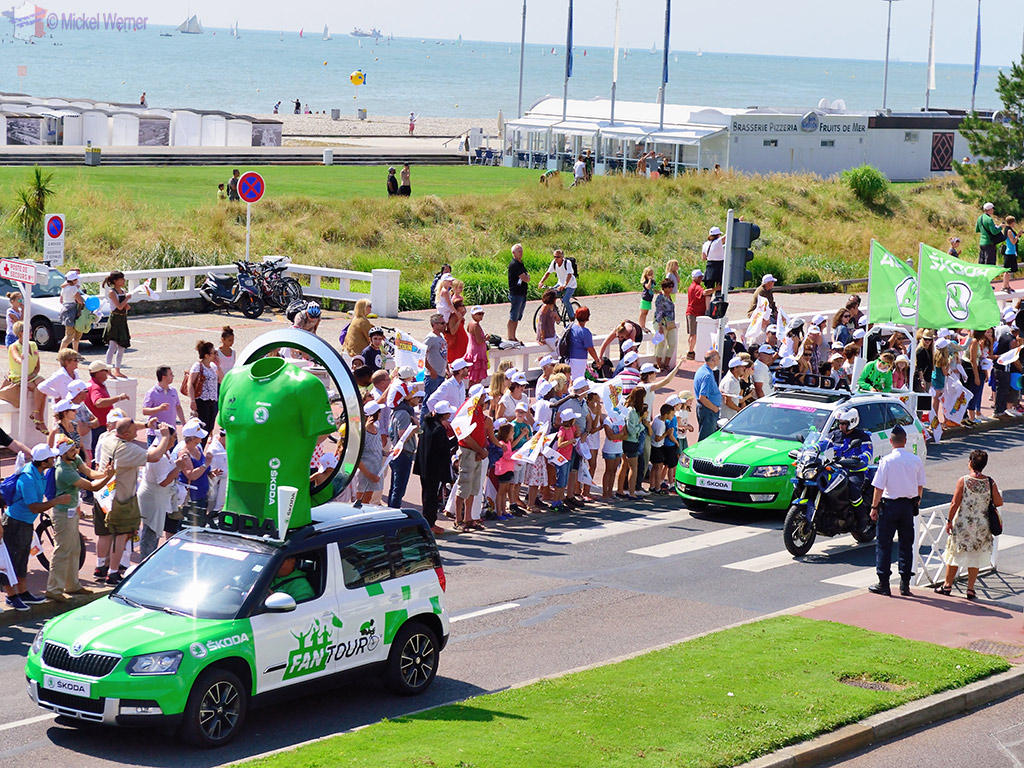

Skoda are not only a main sponsor, they also supply all the official cars for the Tour; officials, stewards, race control, etc.
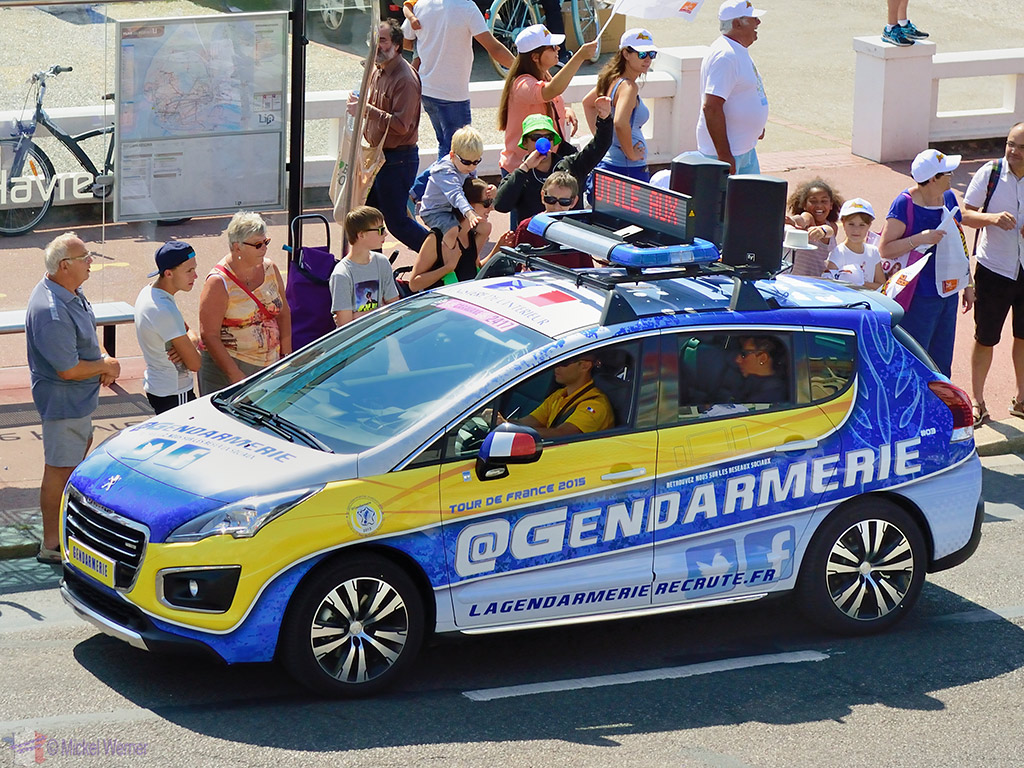
Police recruiting car
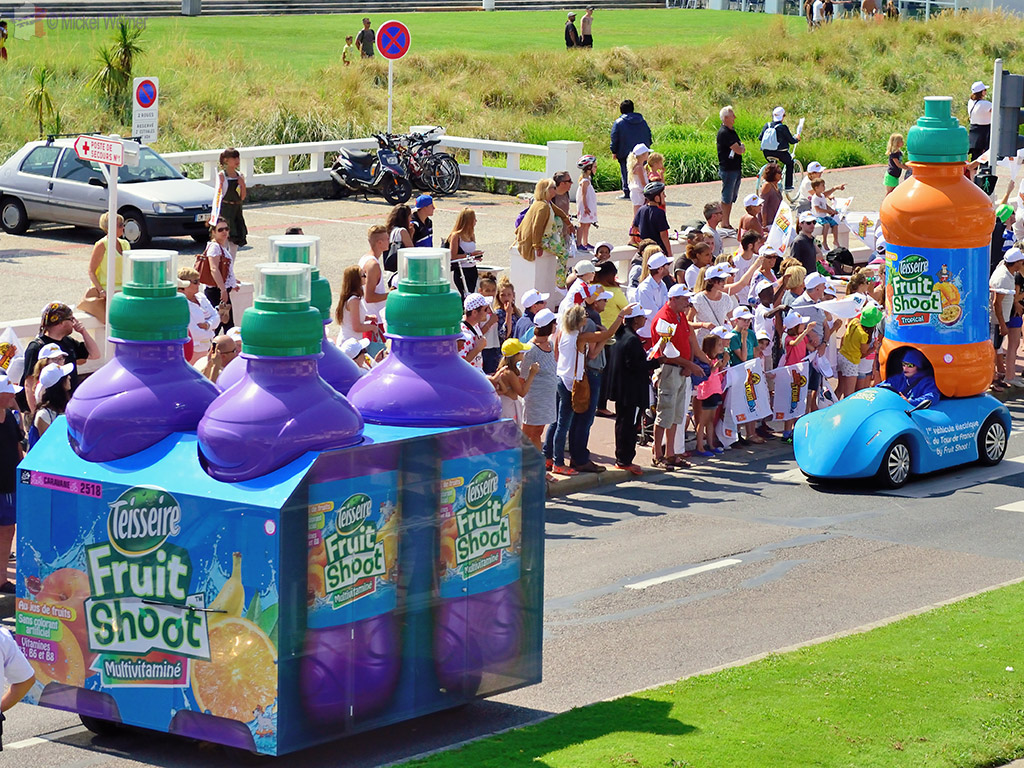
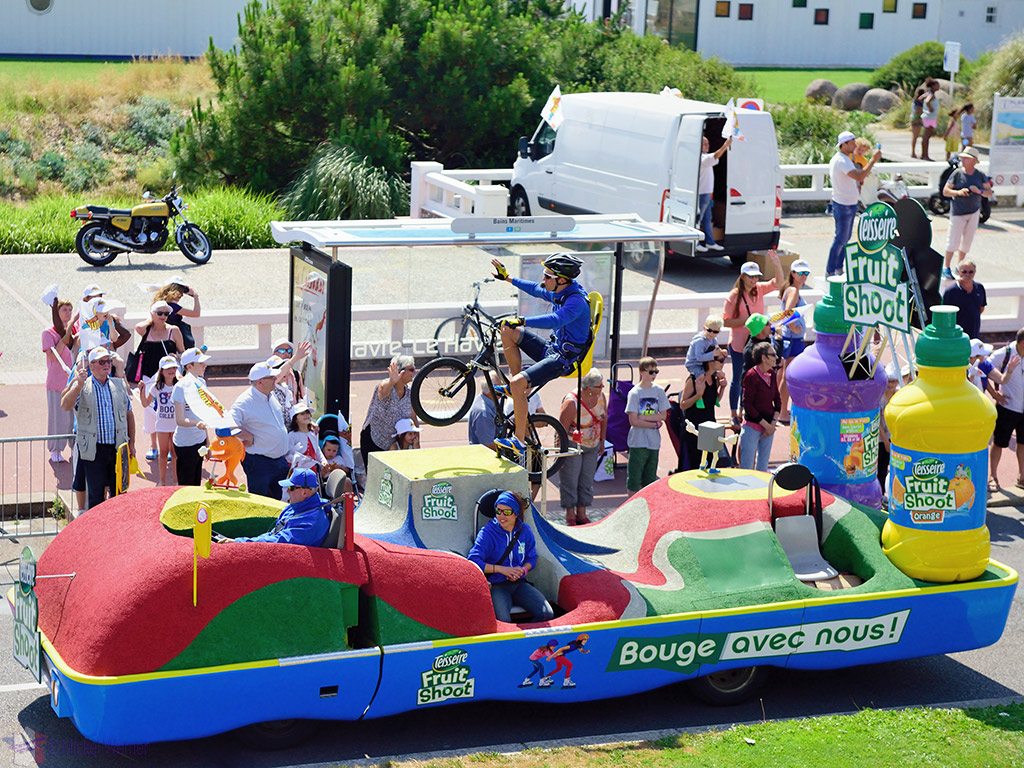
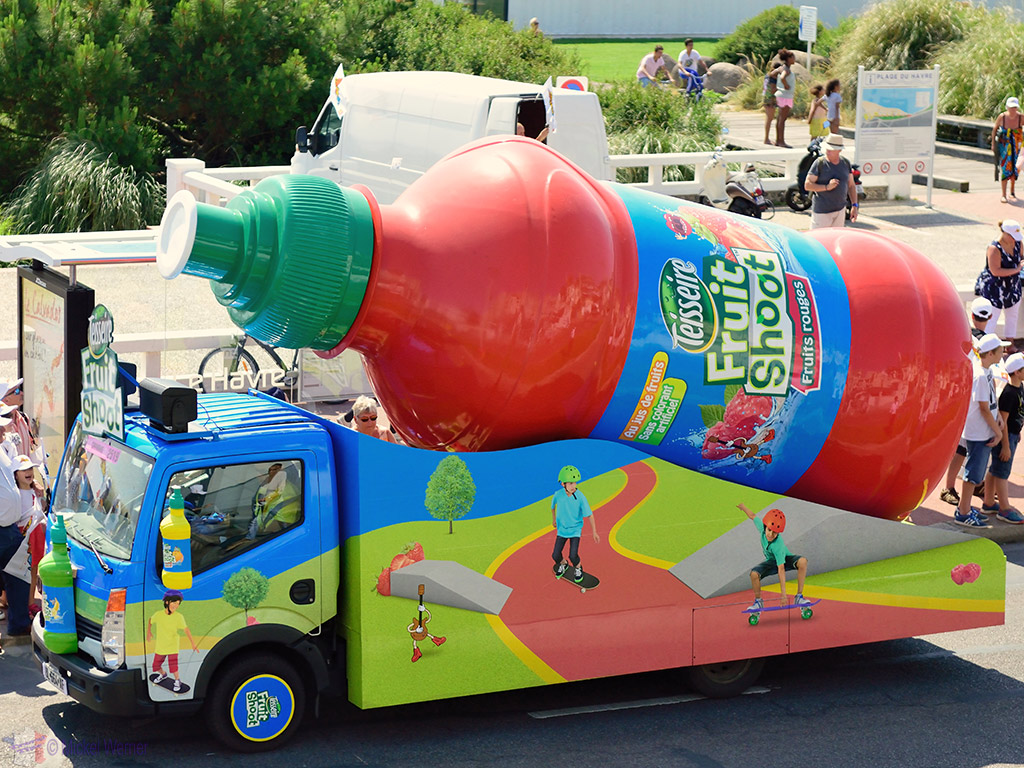
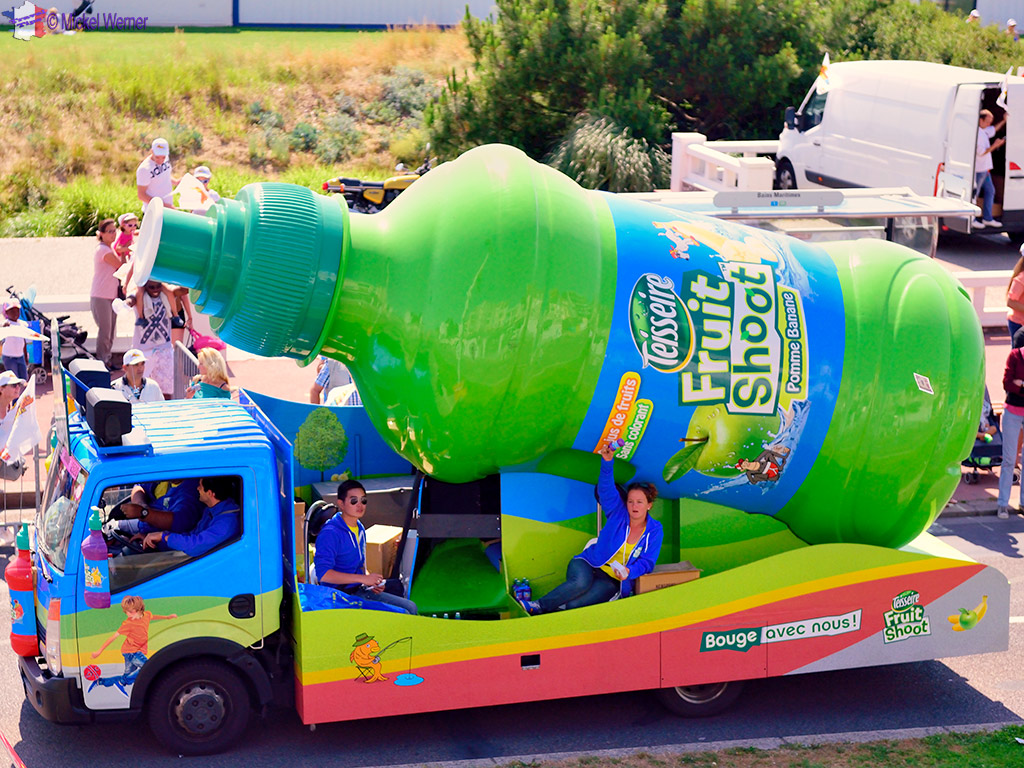
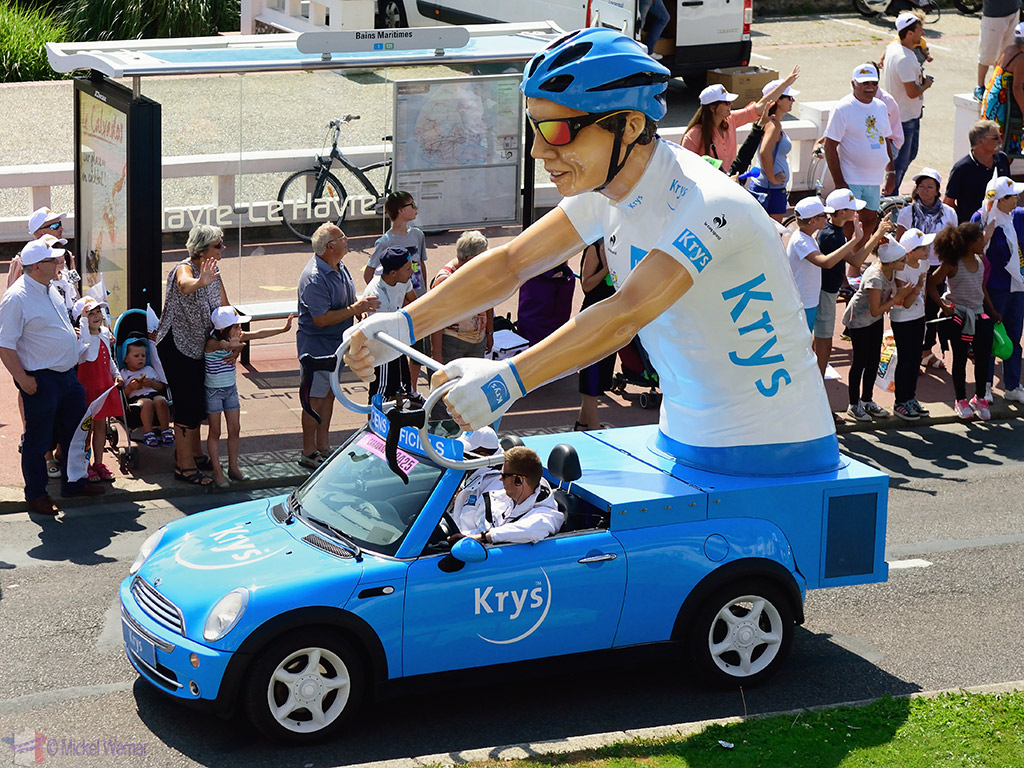
Opticians.
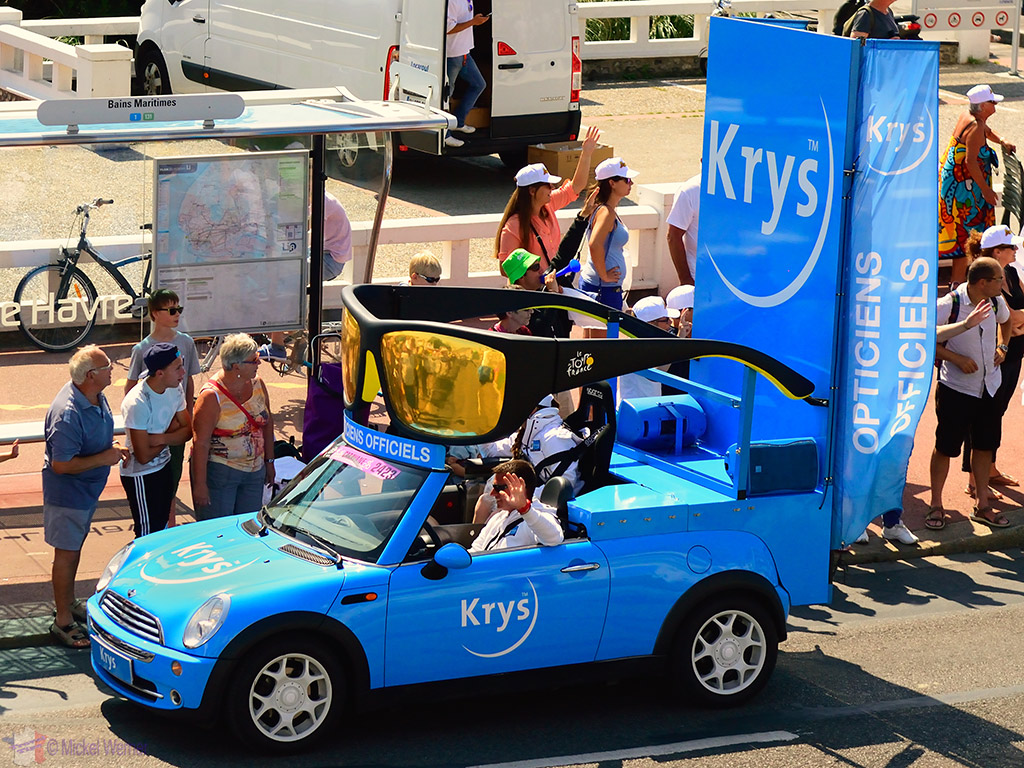
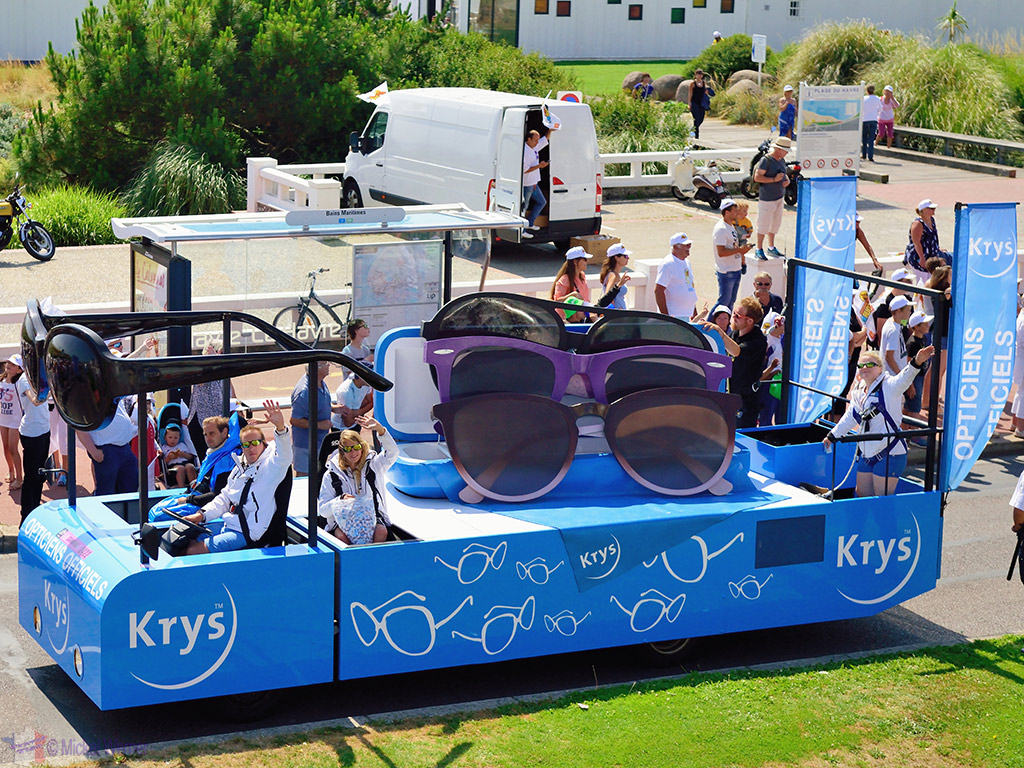

Sweets, very popular with the kids, which is the reason parents were told to keep their kids in check, since many make a dash for these cars.

Old and young, all are claiming the freebees.
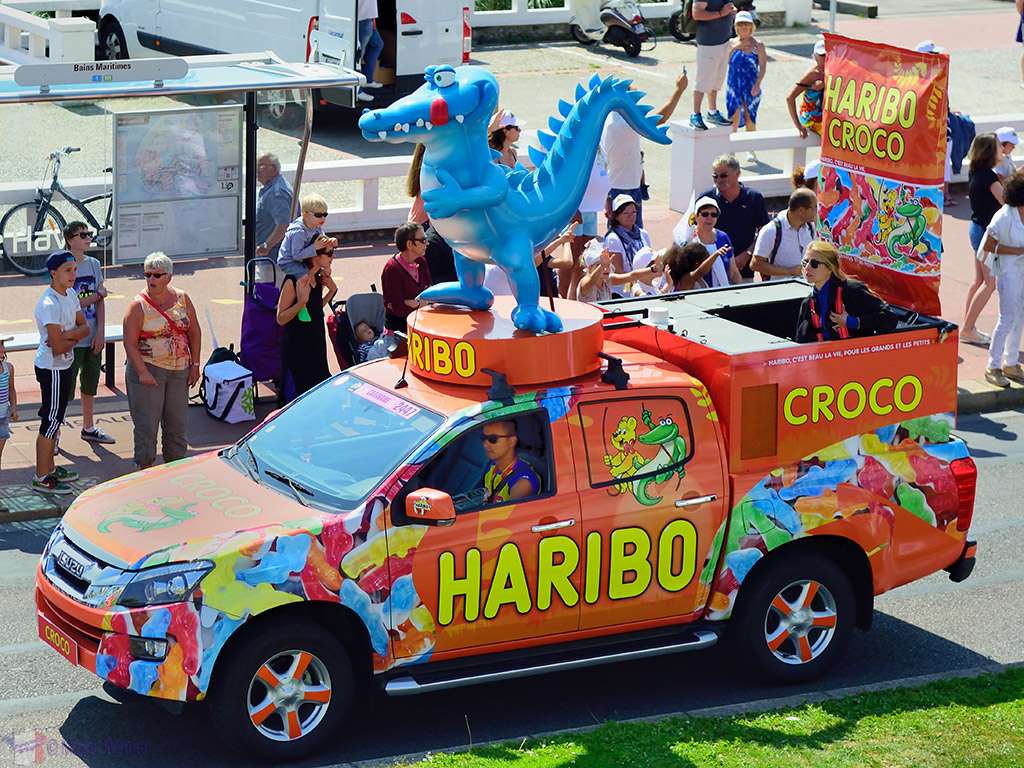

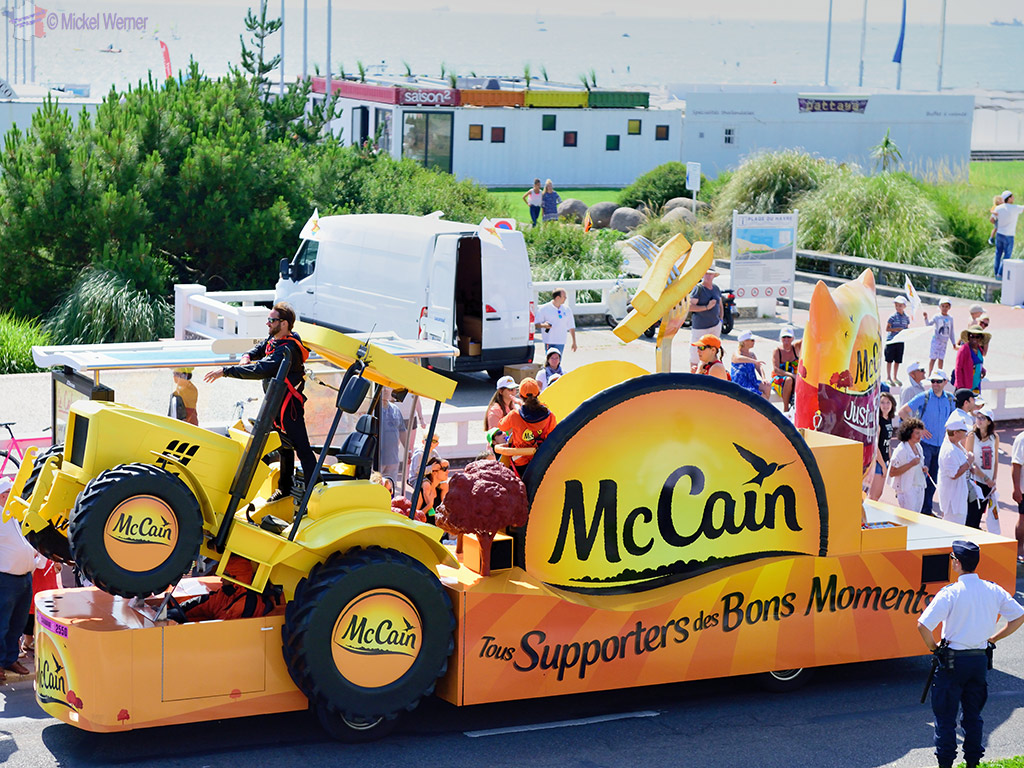
Frozen French fries and hamburgers
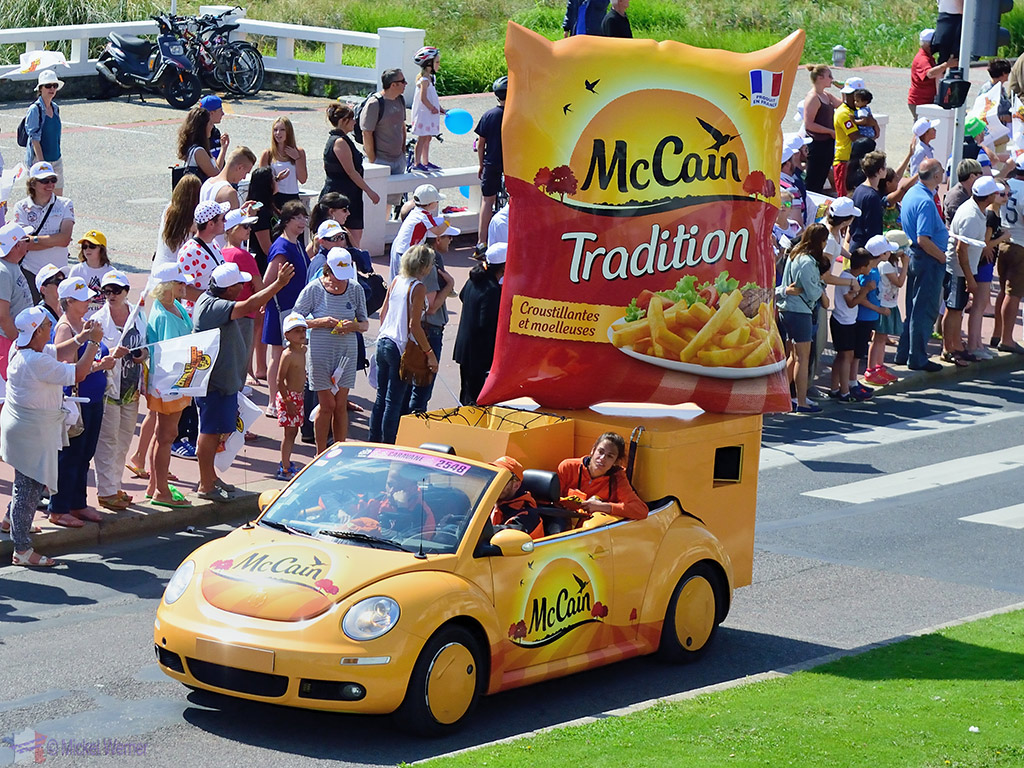

Chickens.

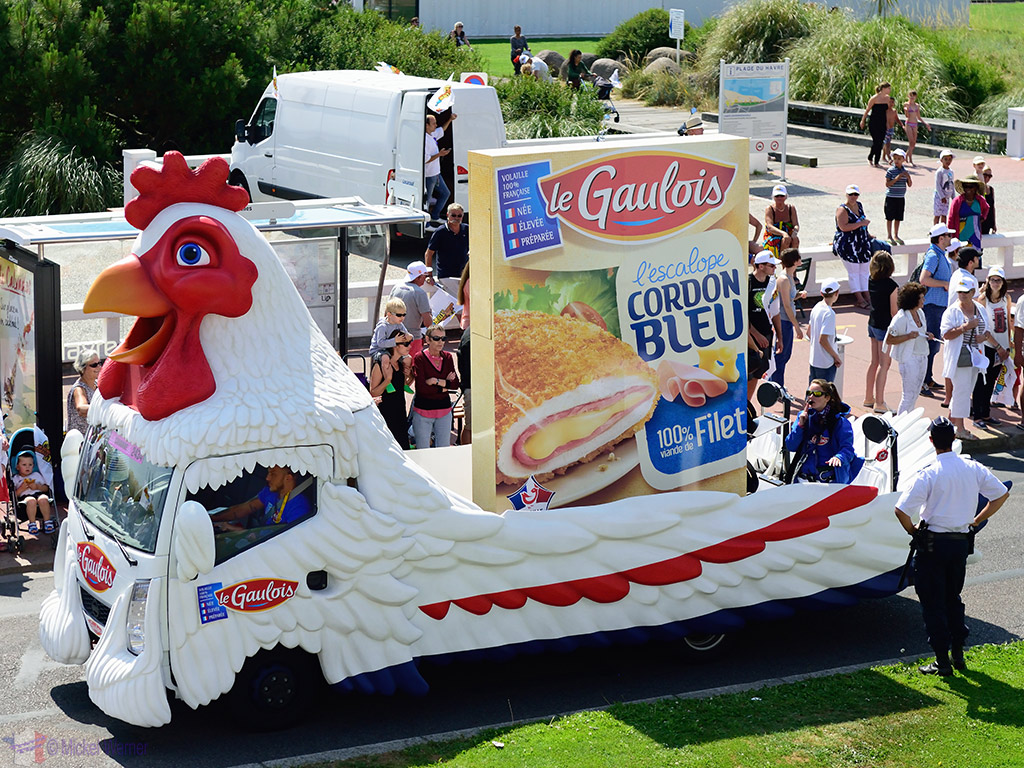

Coffee capsules.
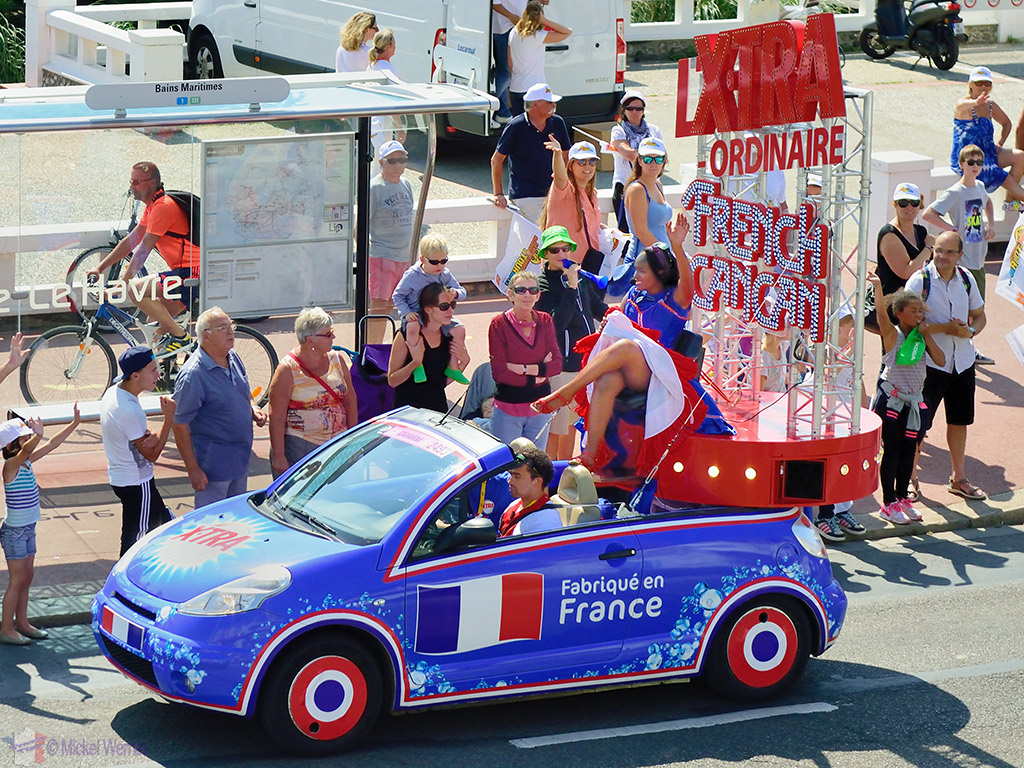
Washing powder.

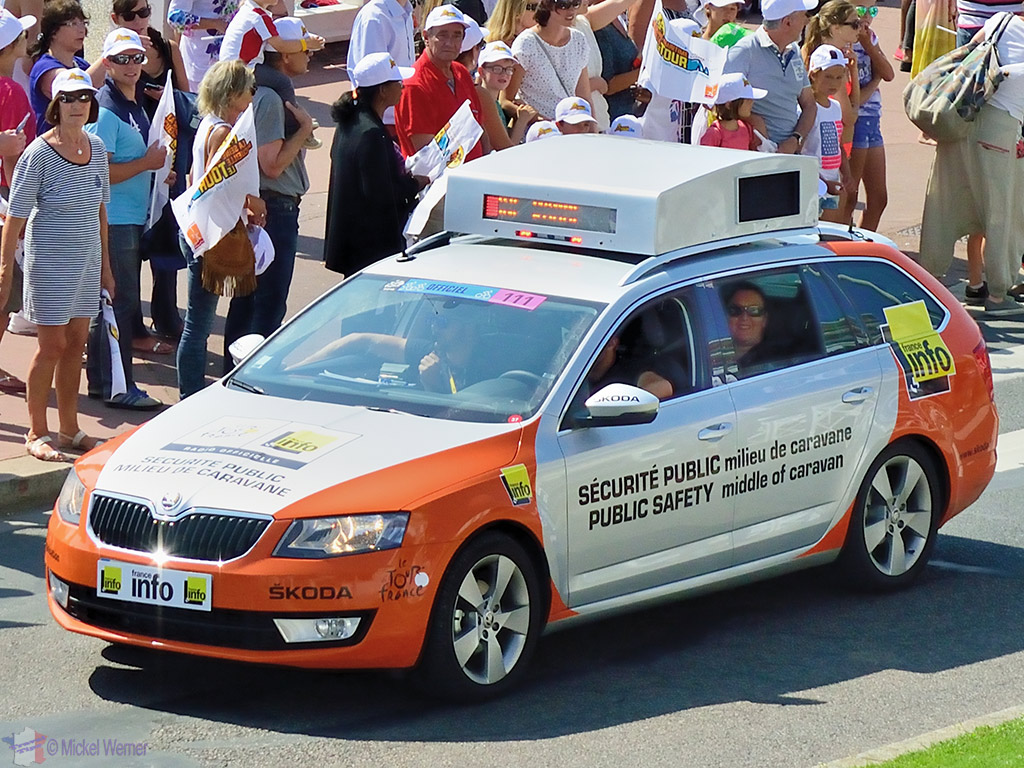
Another public safety car, reminding people to stay safe.

Sausages.
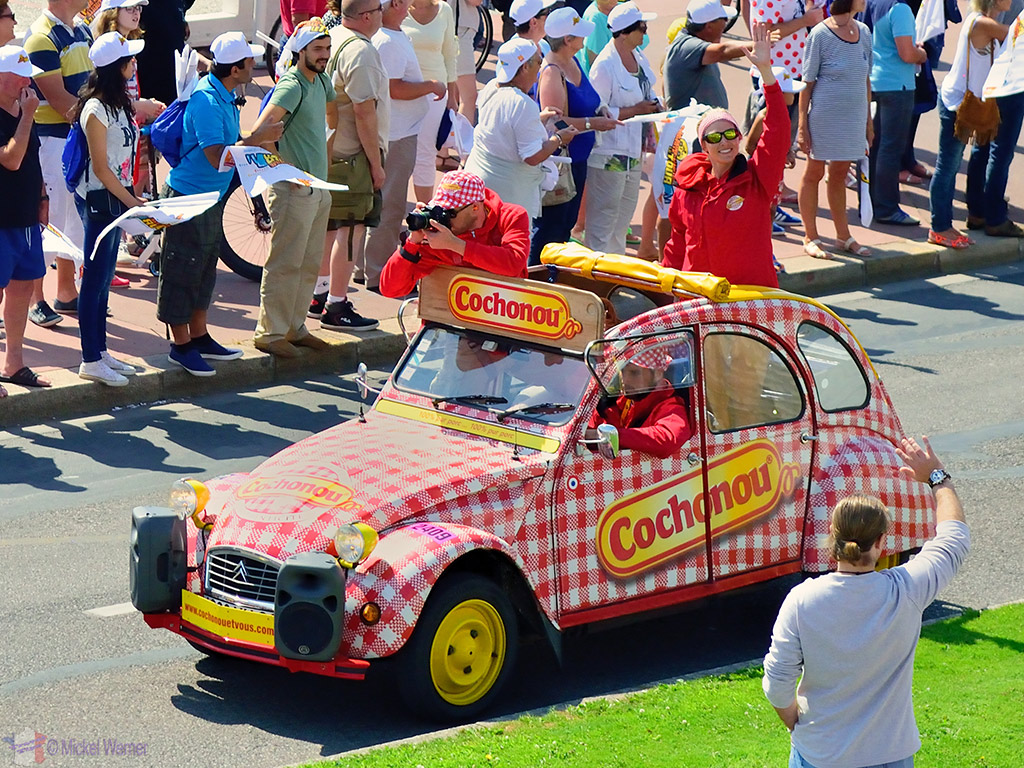

Hotels
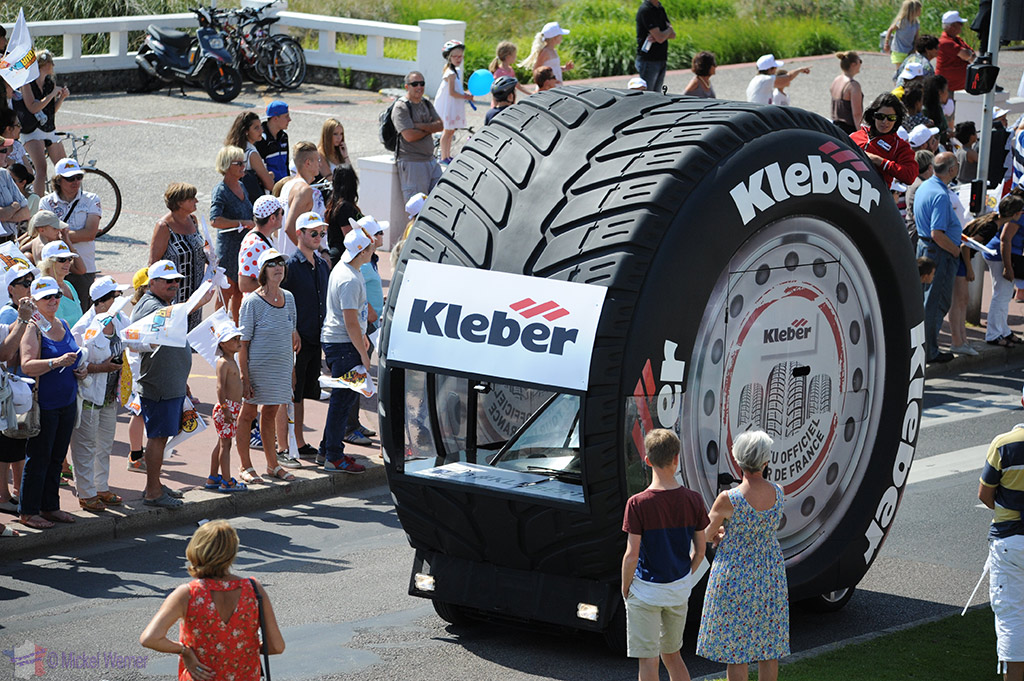
Tires
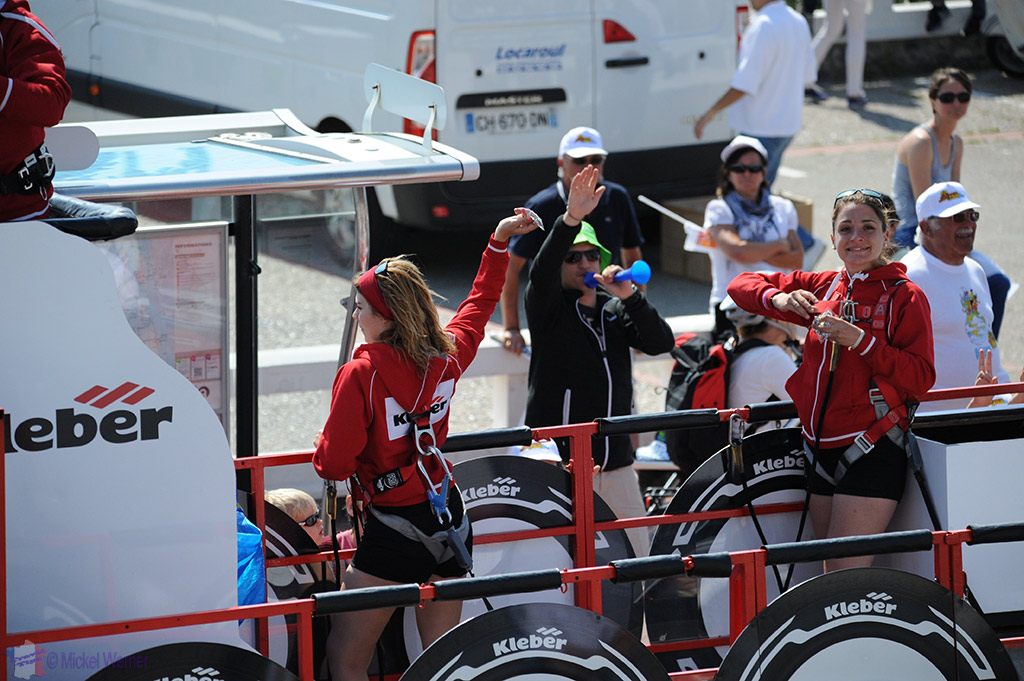
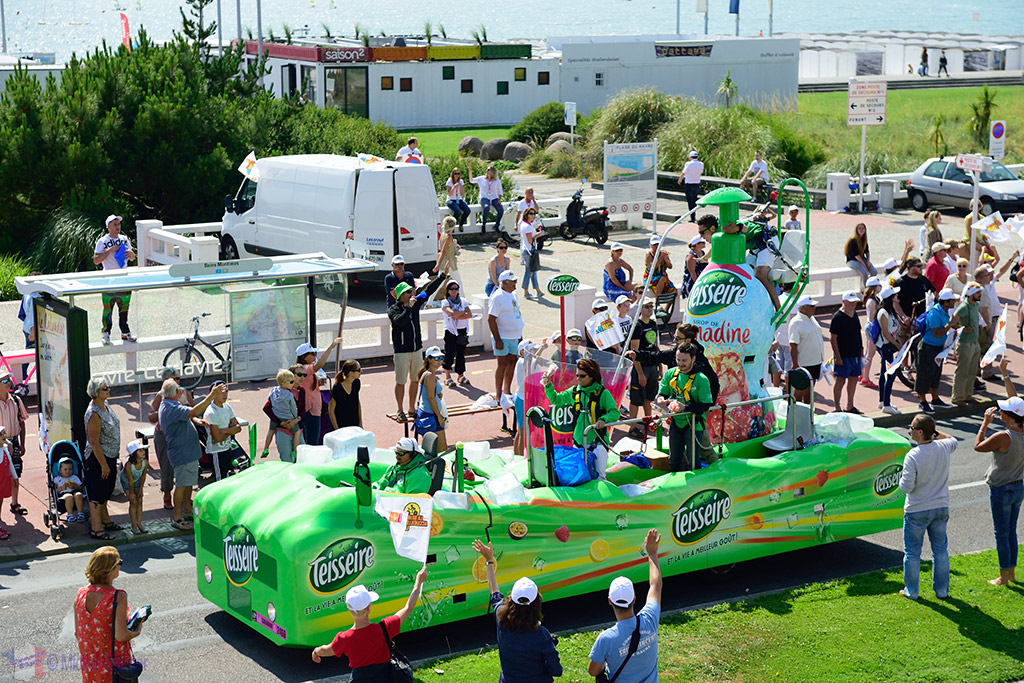
Water based drinks

Children charity
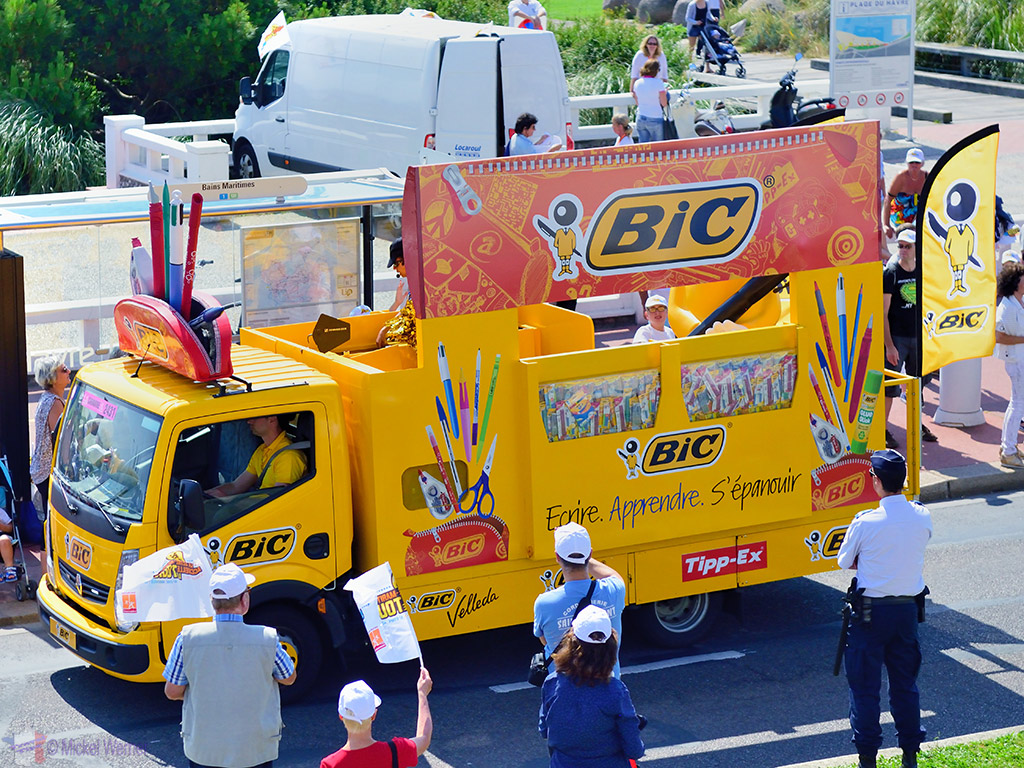
Bic disposable pencils, pens, razors and mobile phones.
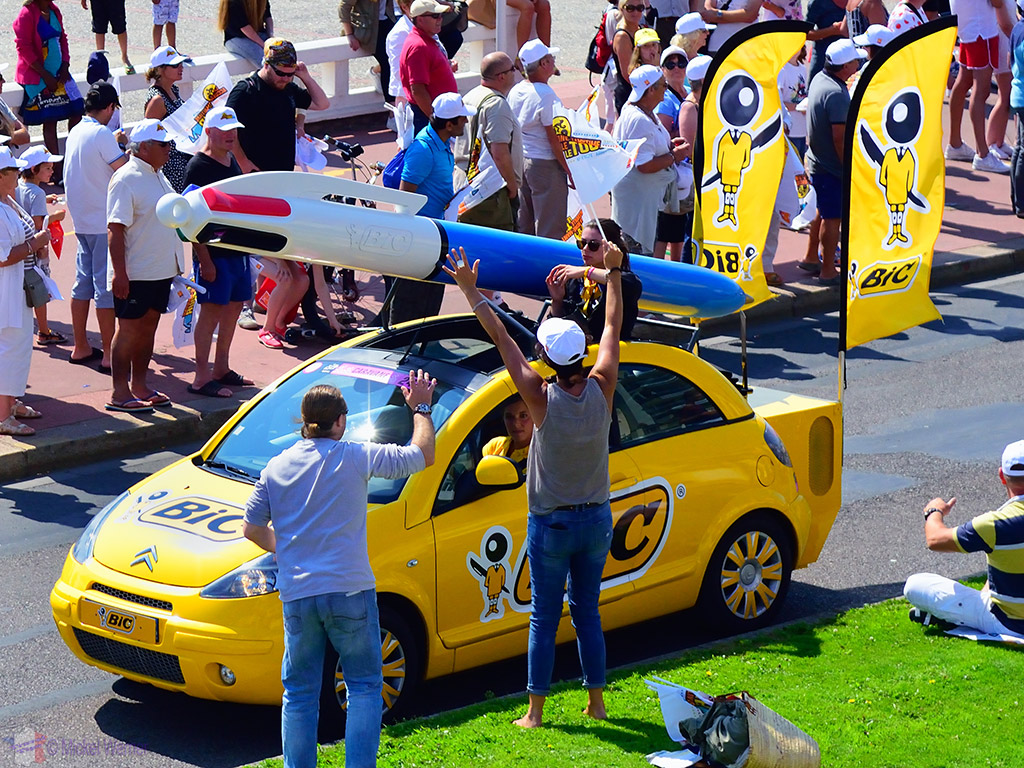
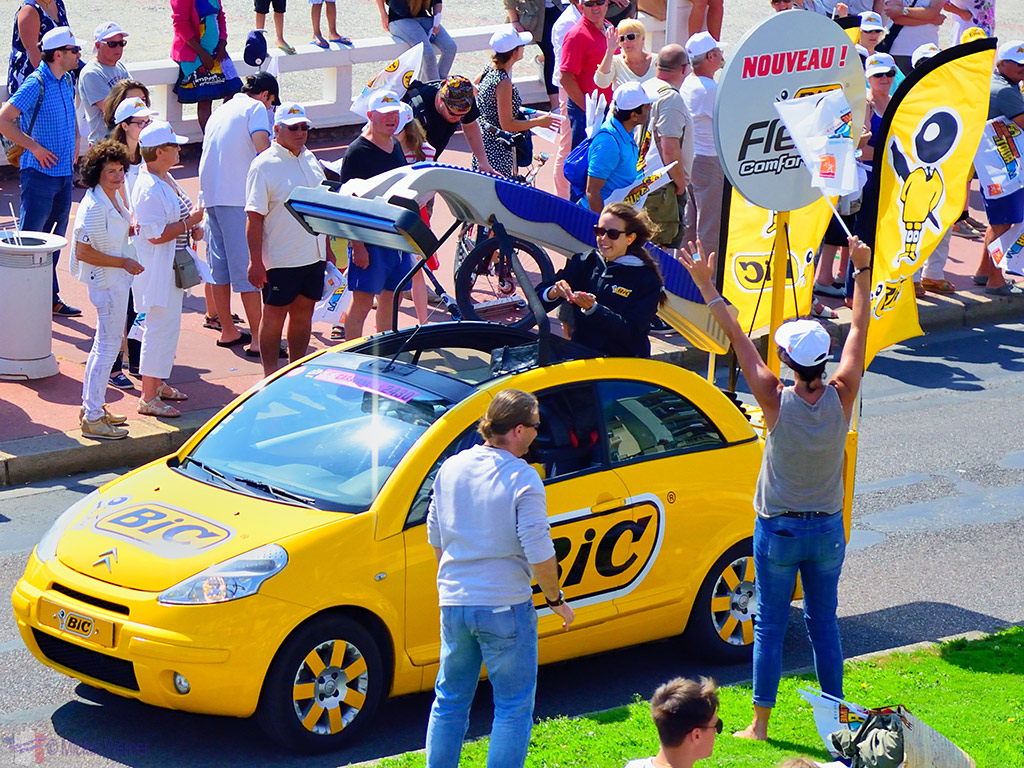
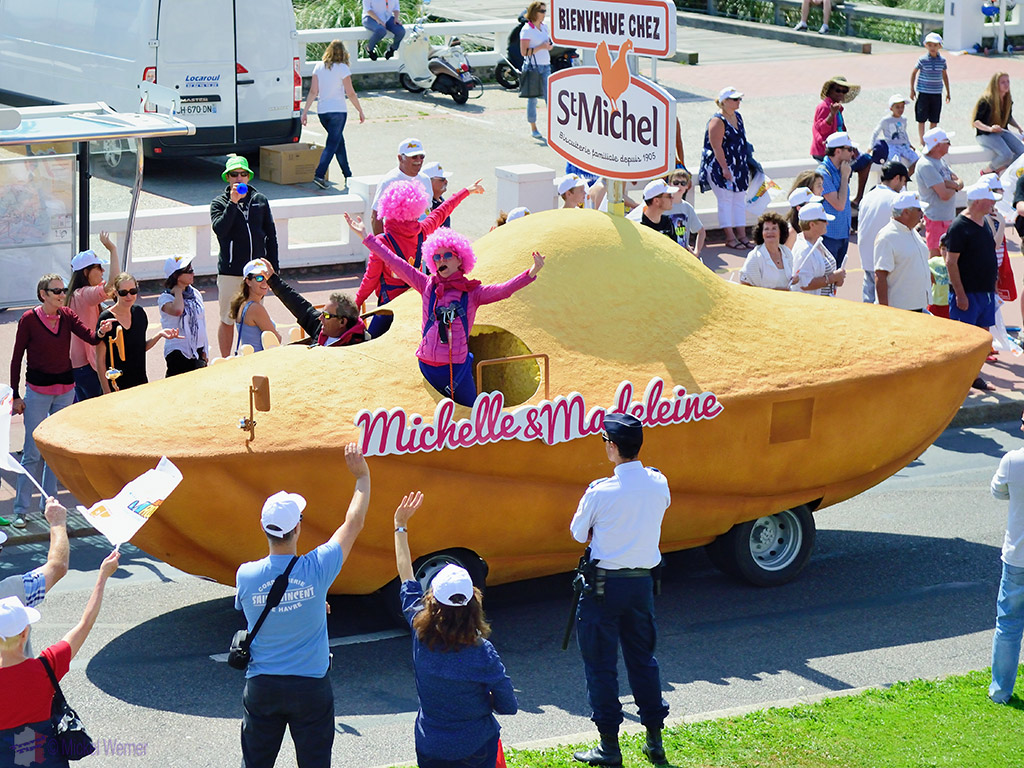
Madeleines, also very popular with the spectators.
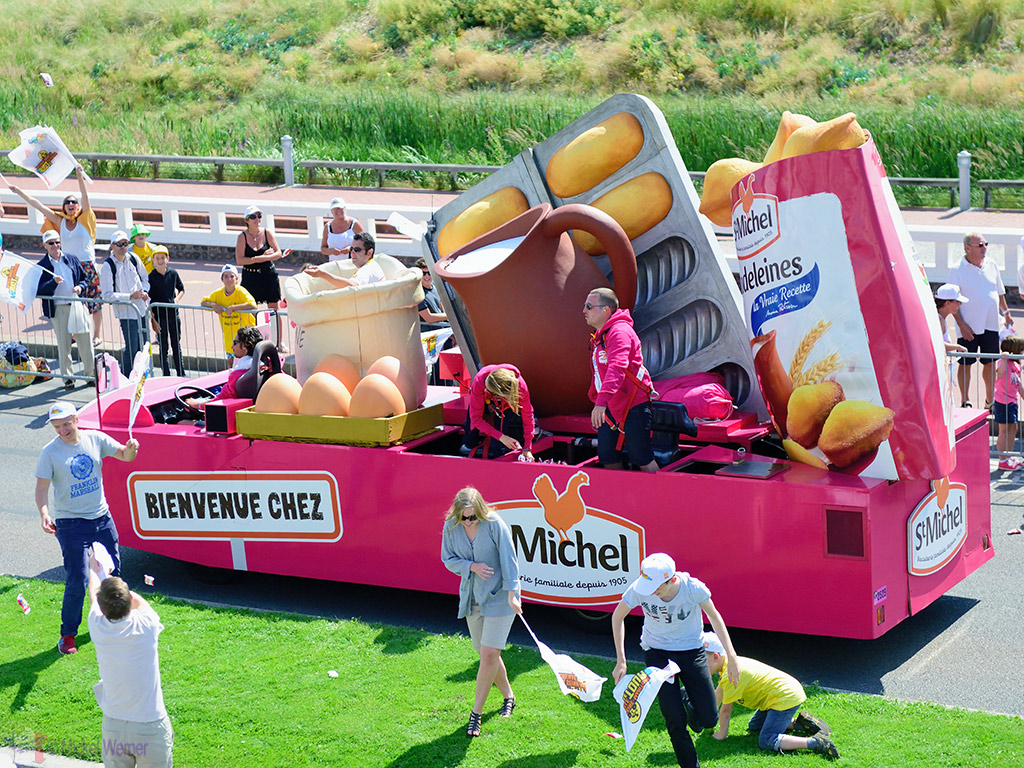
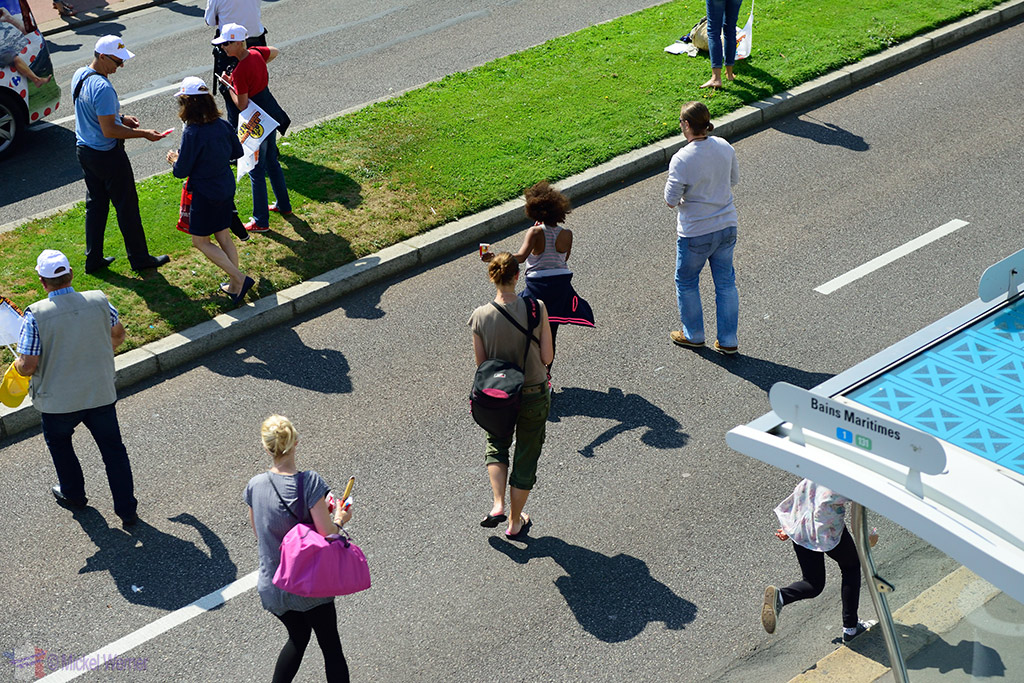
Spectators running to pickup the thrown madeleines from the ground.
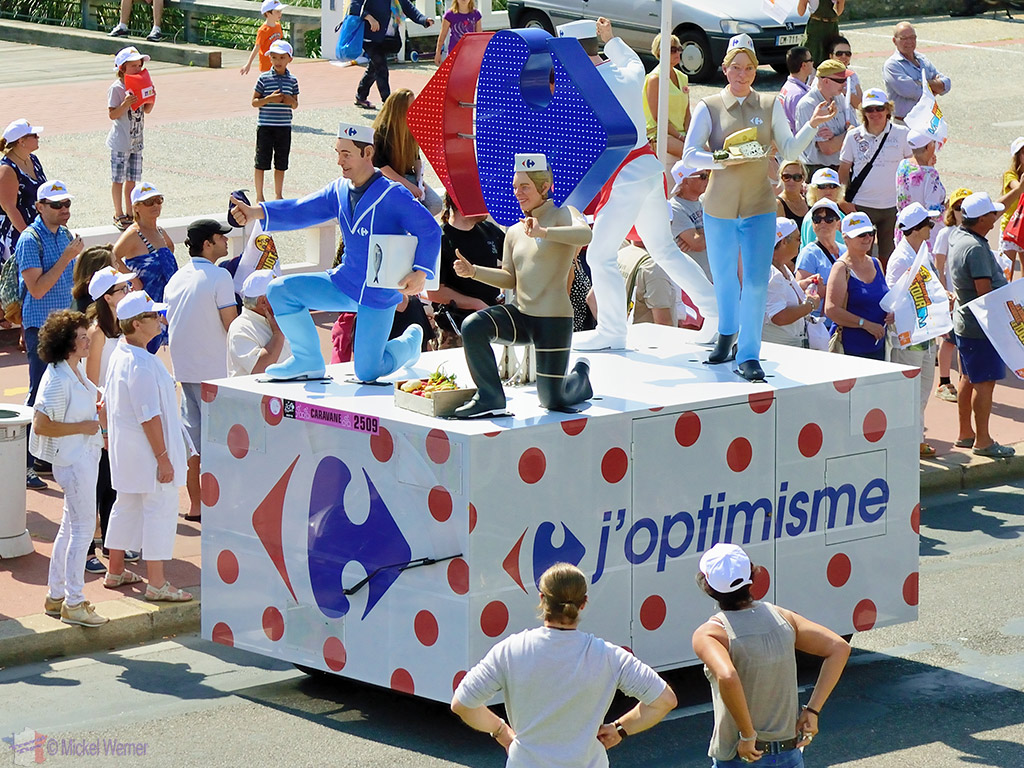
Supermarket

Agriculture seeds.
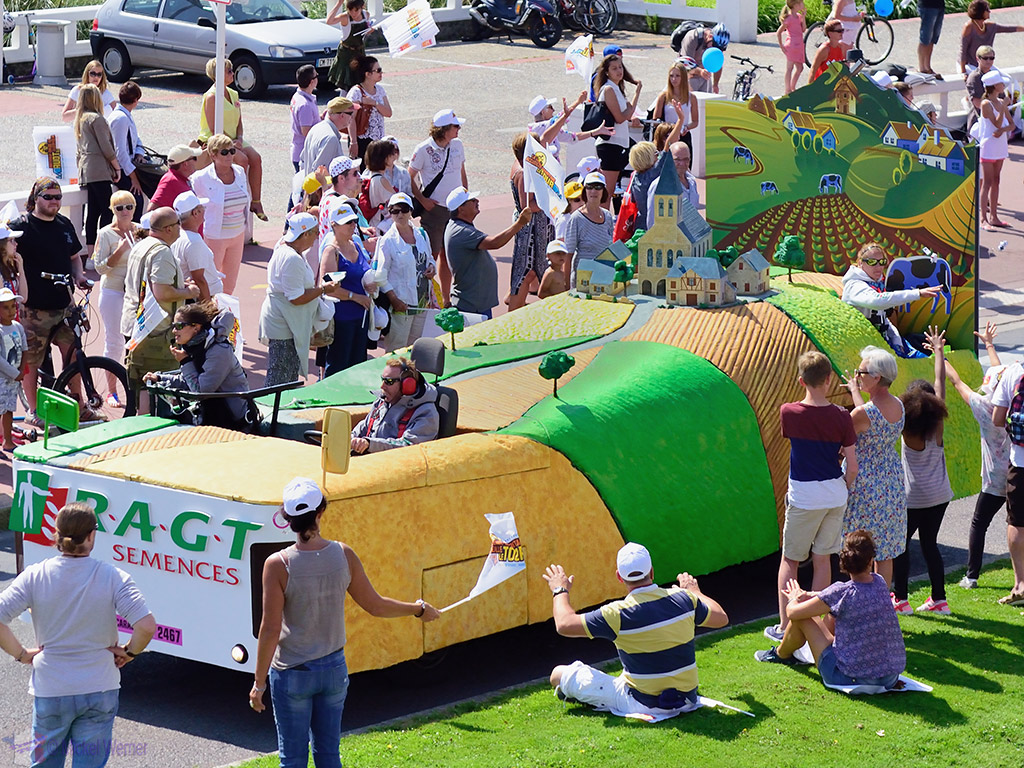
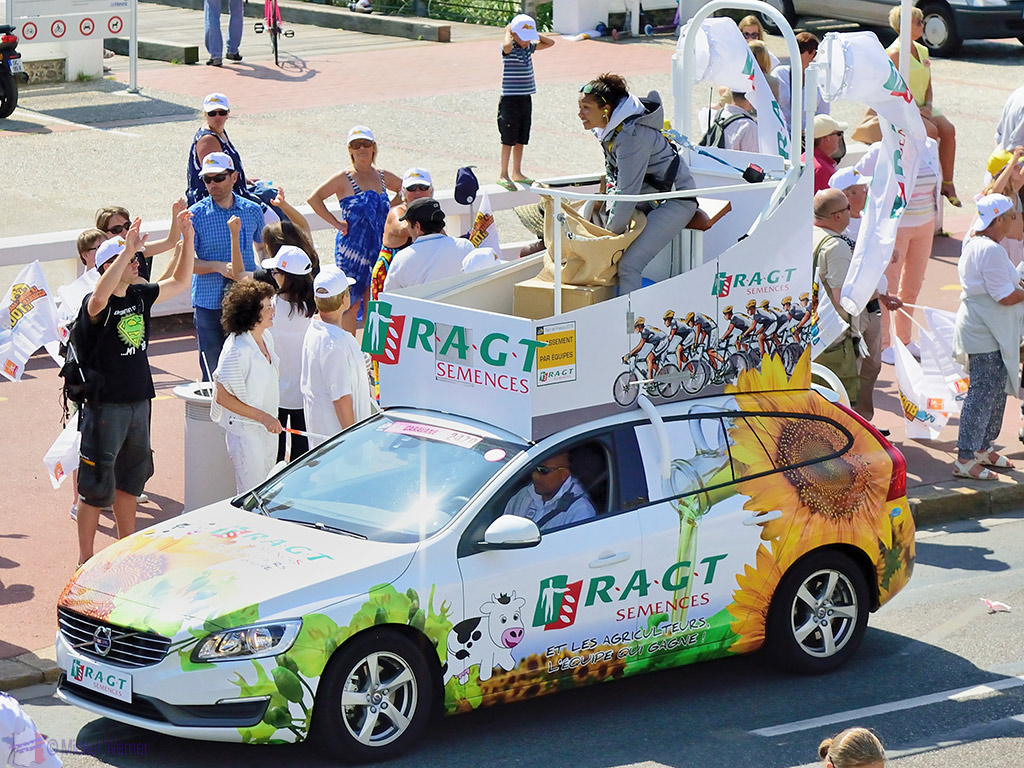
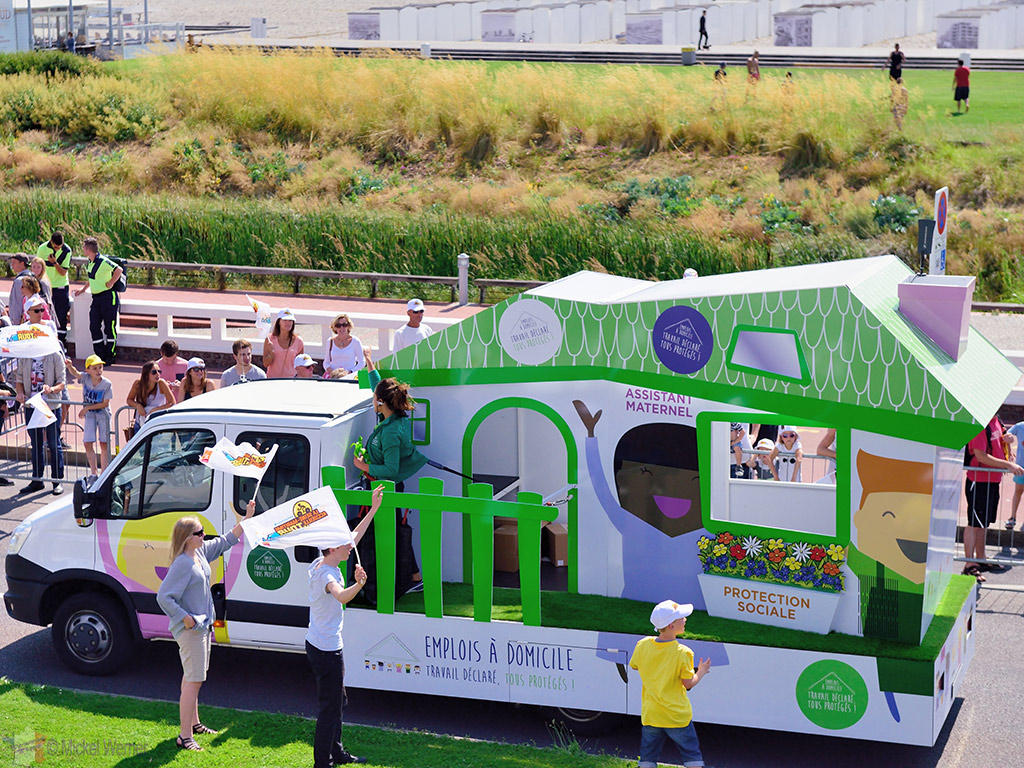
Help at home agency

Bread bakery
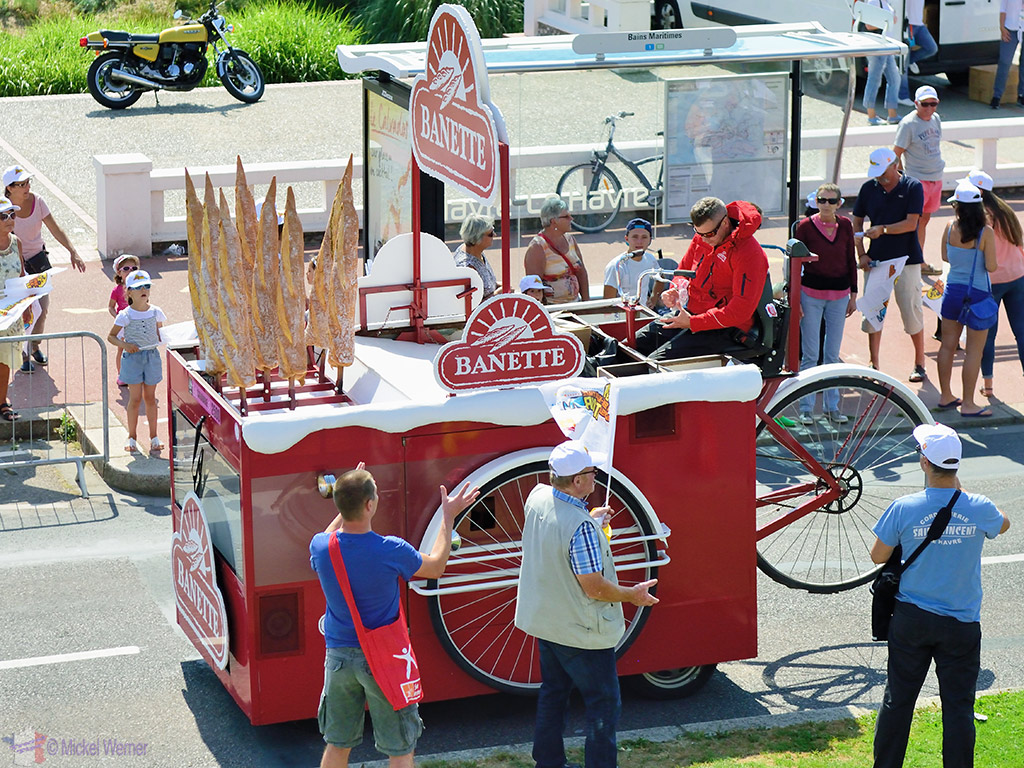
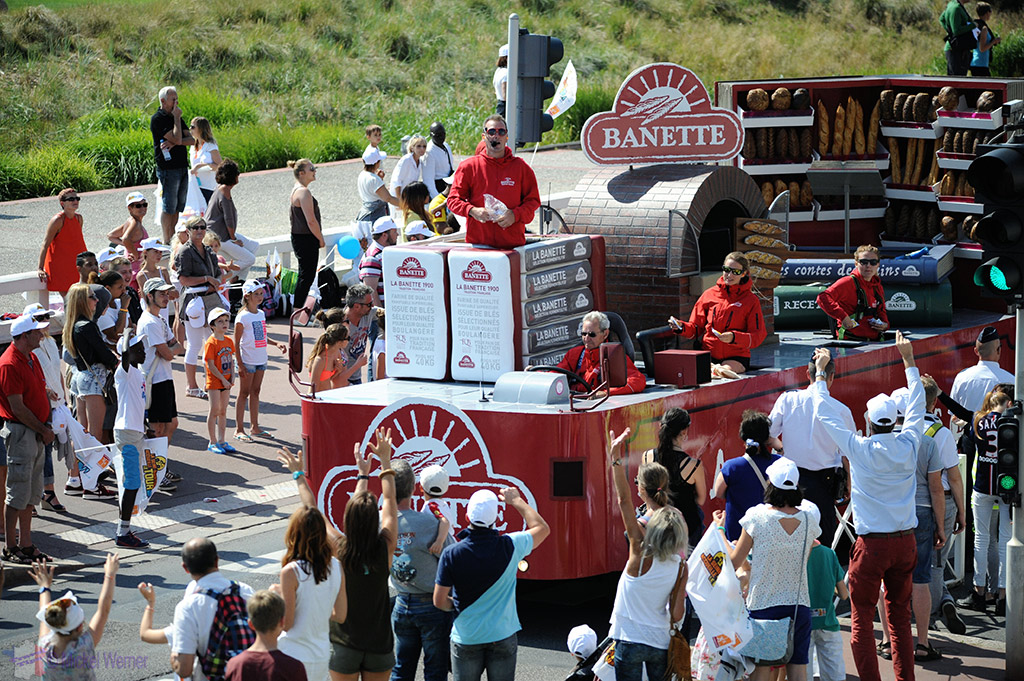
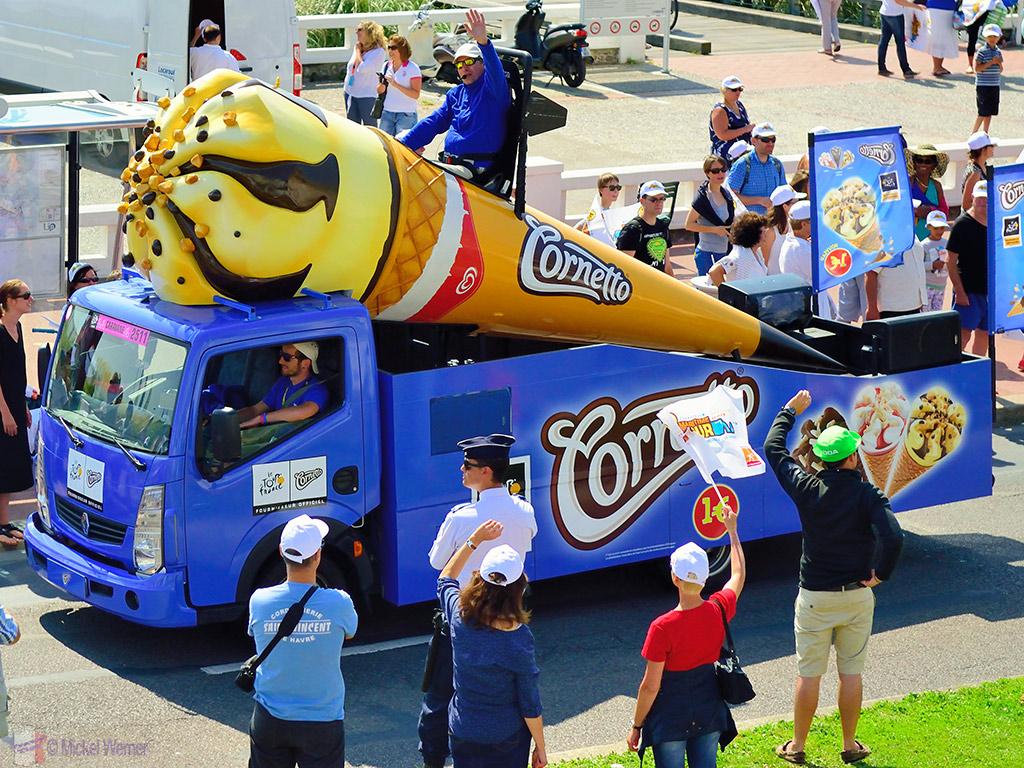
Ice cream

Glue
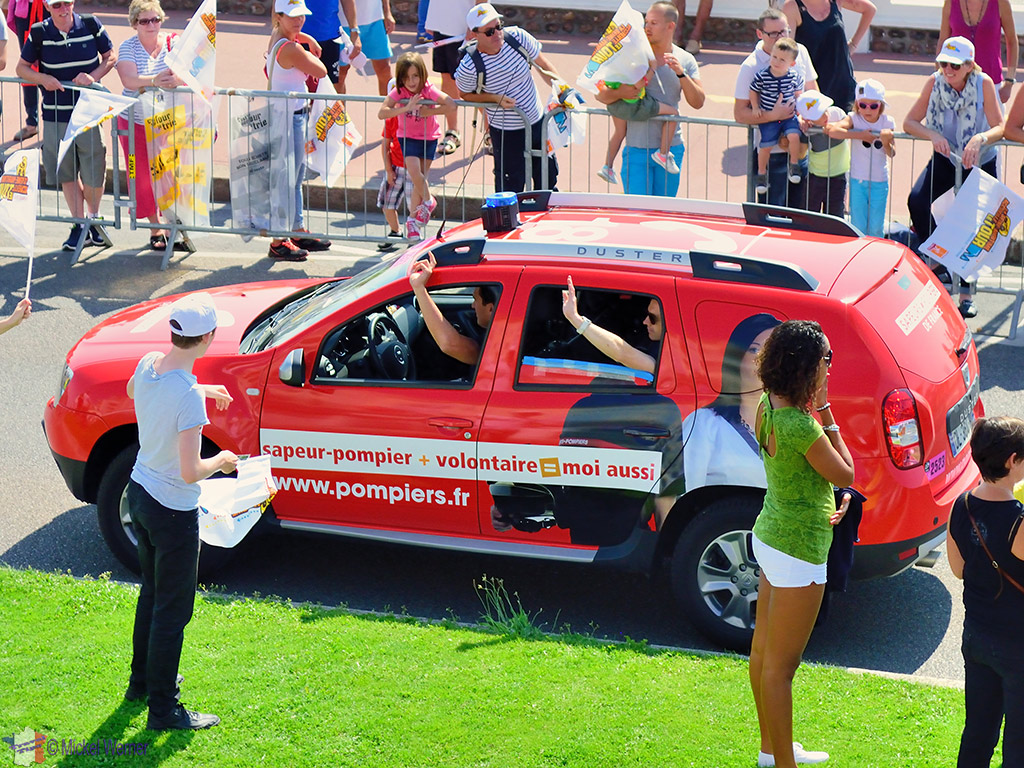
Always very popular, receiving a lot of applause, the fire fighters (looking for volunteers).

Mineral water
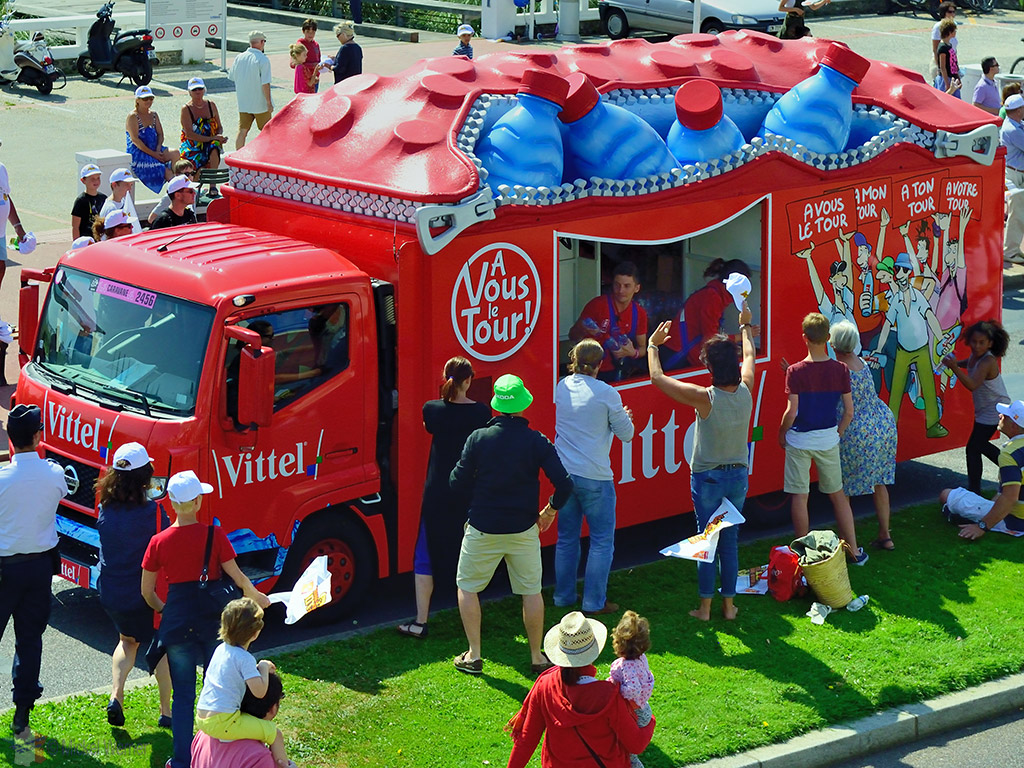
Very popular when it’s hot.
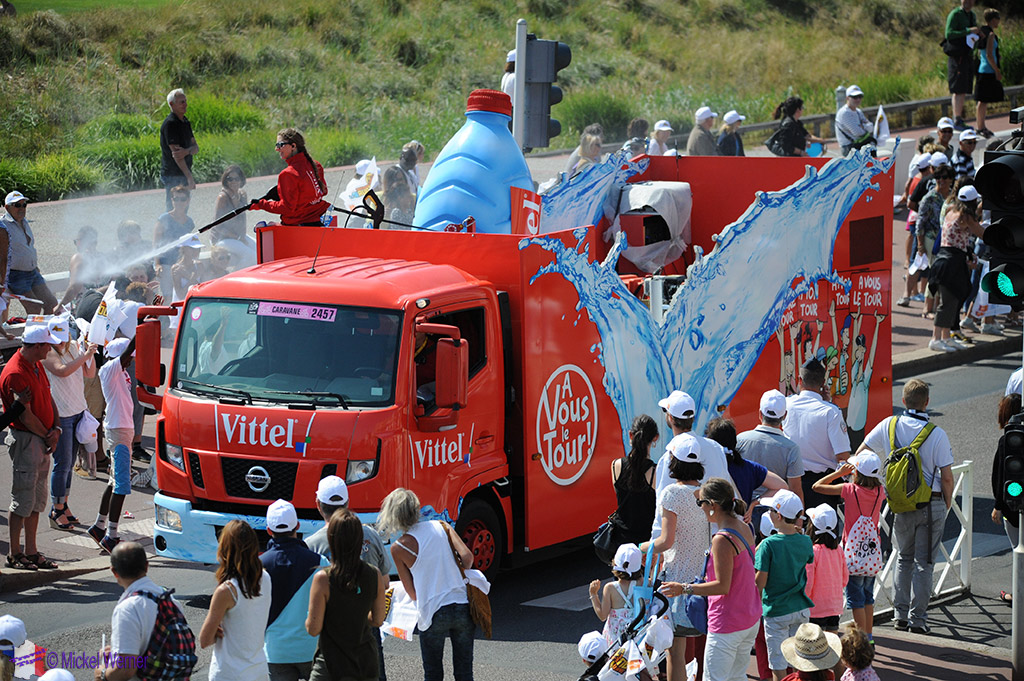
Spraying cooling water on the overheated spectators.

Watches.
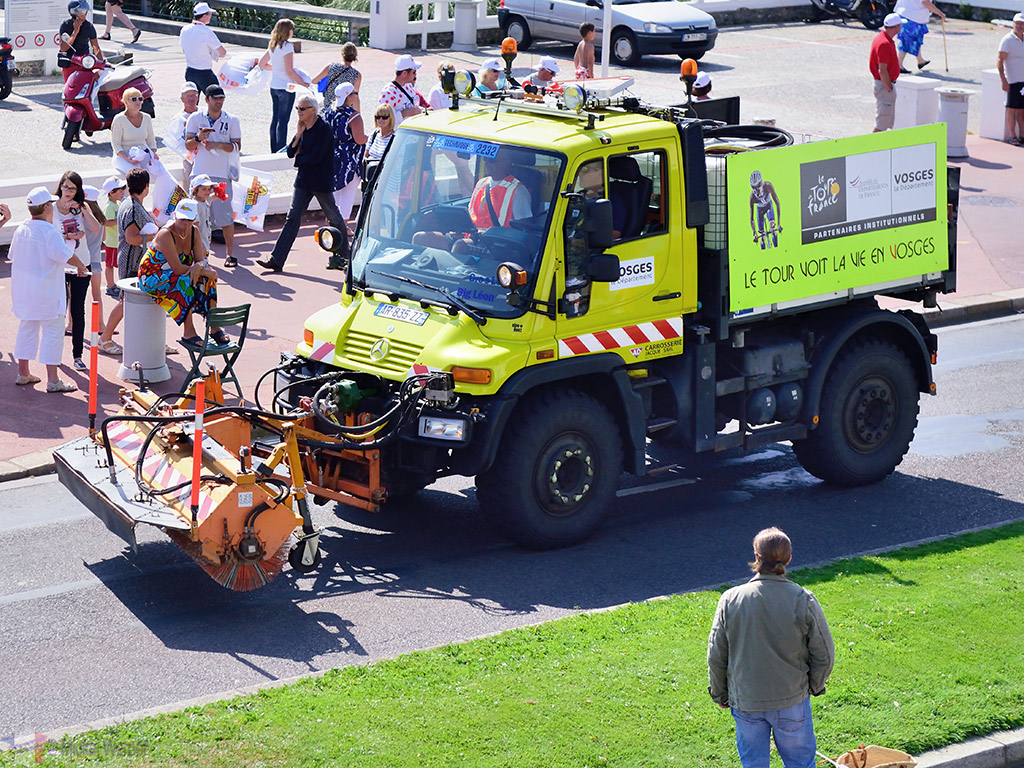
The end of the publicity caravan is marked with several cleaning trucks, making sure that there is no rubbish on the road for when the cyclists arrive.
17:06

The first live broadcasters arrive on their motorcycles. The pillion on the motorcycle is the radio (or TV) broadcaster, often interviewing key people while riding next to them on their motorcycle. No, not the cyclists, but team staff that are travelling in the support cars.
On a side note, the motorcyclists need a special permit to ride in the Tour, and it requires a mandatory training and exam every two years at the motorcycle police training academy. The reason for that is the motorcycles get very close to the cyclists, and every year, at least one motorcycle will hit a cyclist. If this is the case, no matter who is to blame, the motorcyclist has to leave the Tour and is never allowed back.
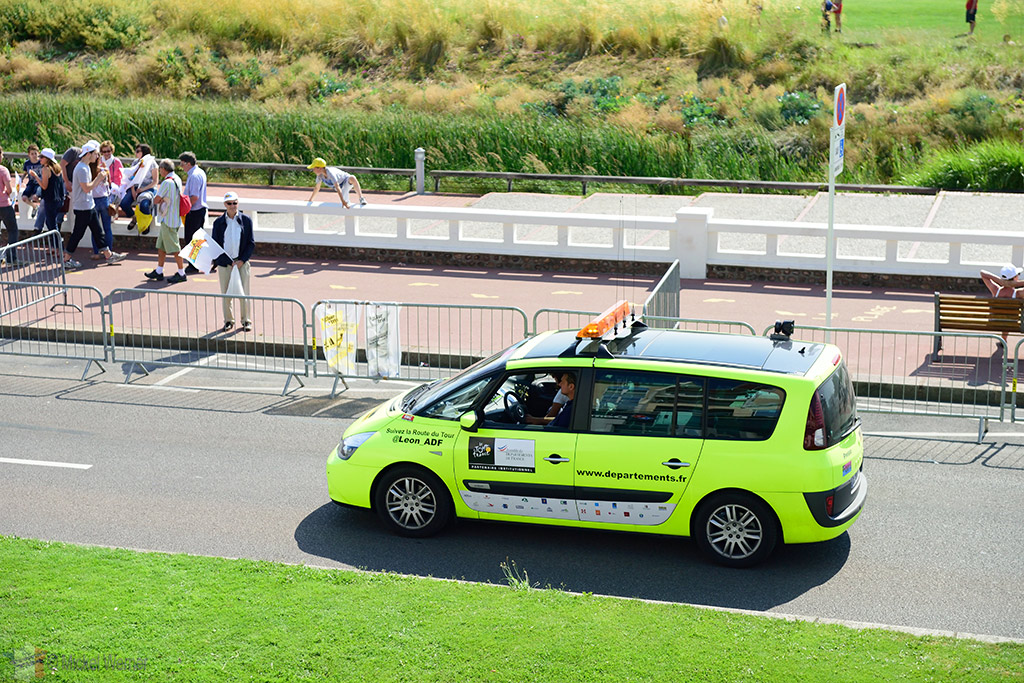
More and more safety and support vans and SUVs arrive.
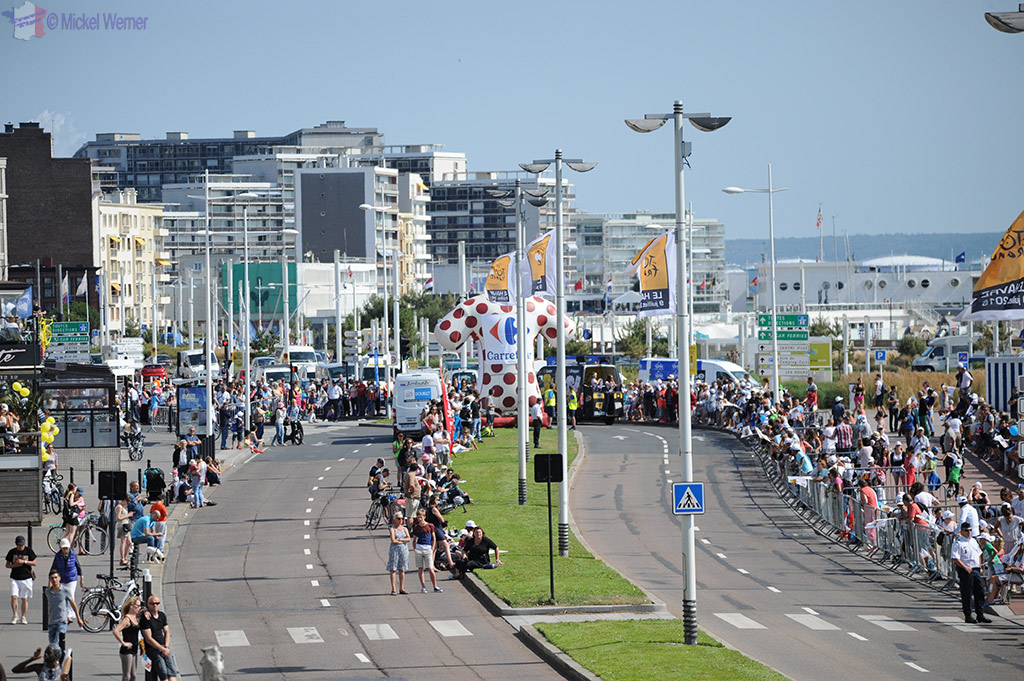
The remaining spectators have mostly moved to the curve so they can get a better view of the cyclists.

The first support vehicles of the teams start arriving. These are usually the team logistics and other members.

The last vans selling Tour souvenirs arrives, but mostly sell nothing.
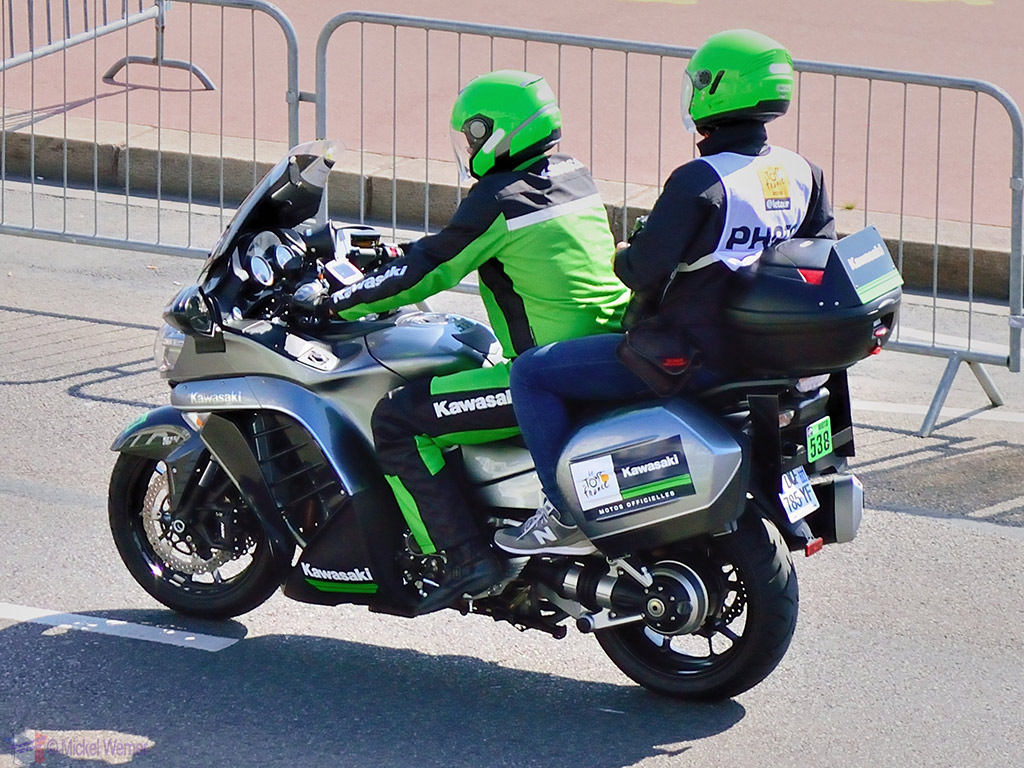
And then many motorcycles start arriving. This is a pool photographer (in other words, he will be sharing his photos with other publishers) on an official Tour motorcycle. Like Skoda is the official car of the Tour, Kawasaki is the official motorcycle of the Tour. In other words, all official motorcycles are Kawasaki.

Officials, usually stewards and marshals, on the official motorcycle of the Tour. They manoeuvre through the cyclists making sure that the race rules are respected.
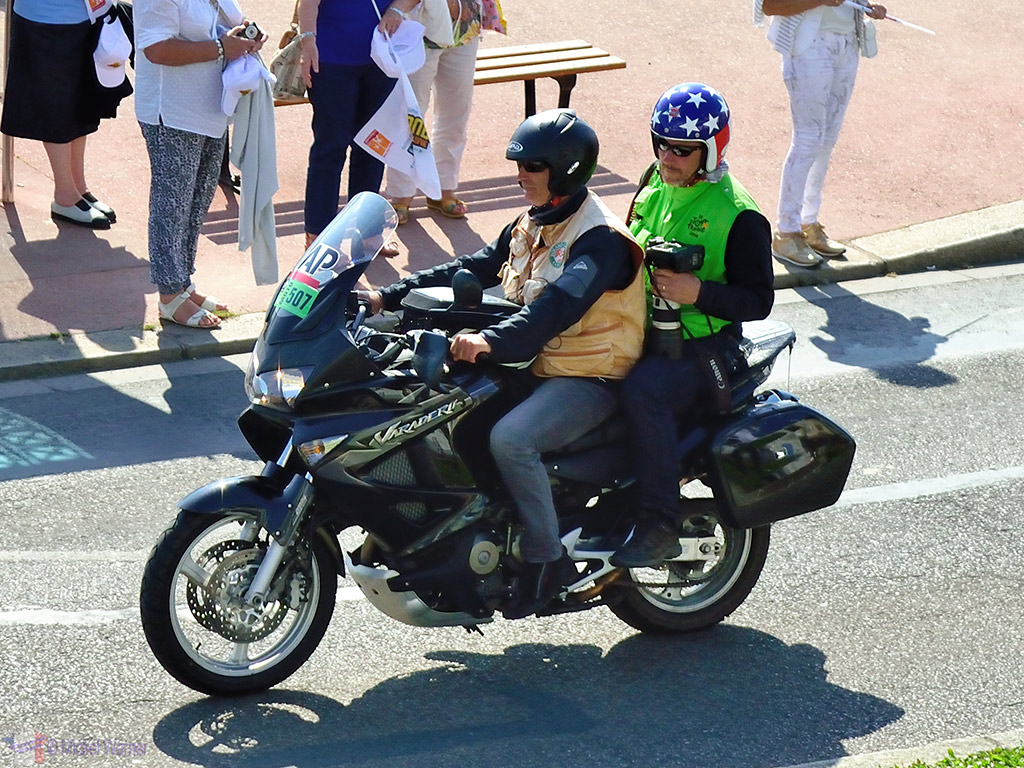
A press photographer from the AP (Associated Press) news agency on their own motorcycle.
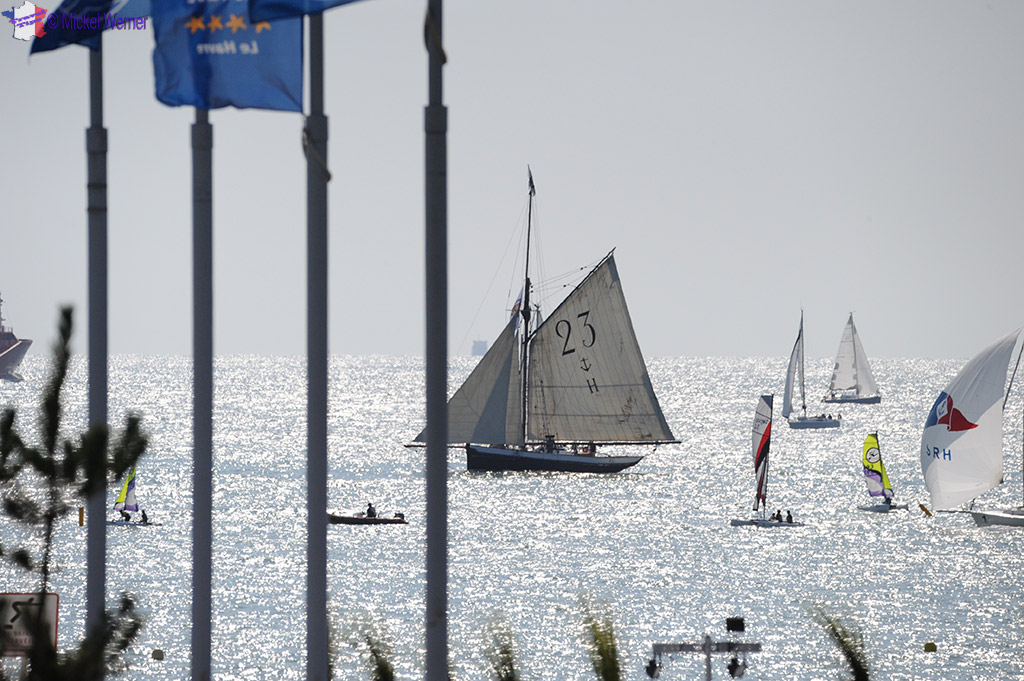
Several boats have arrived to see the show unfold from the sea.
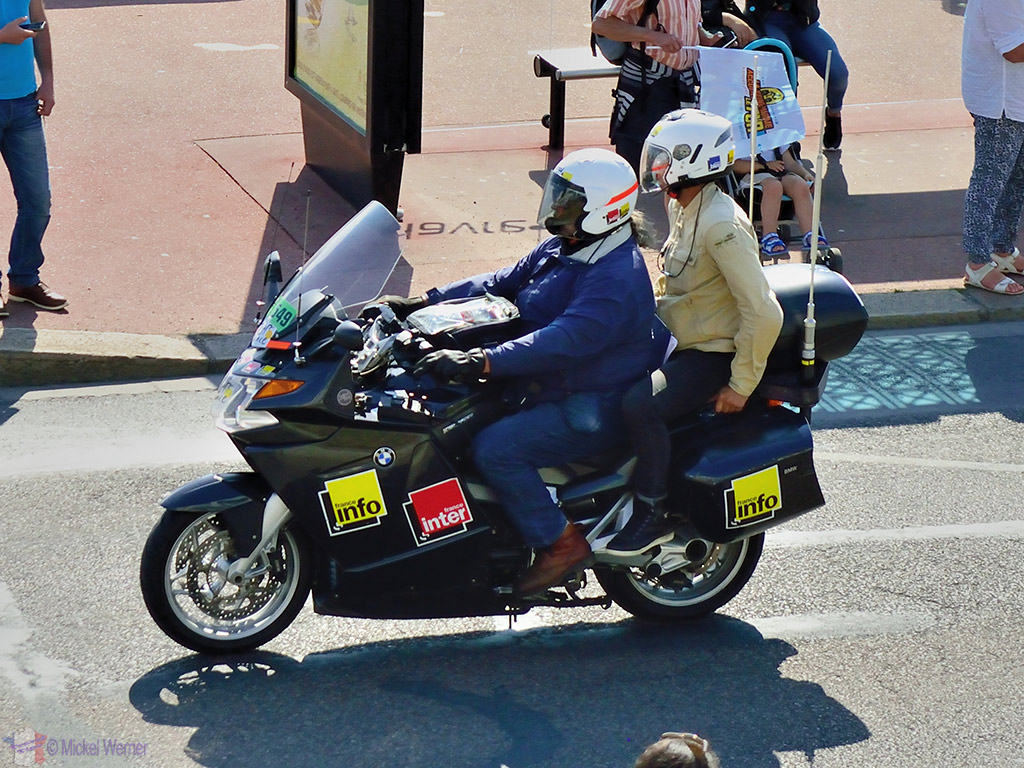
The first live broadcasters arrive on their motorcycles, working for radio or TV. This one is for two radio channels, France Info and France Inter.
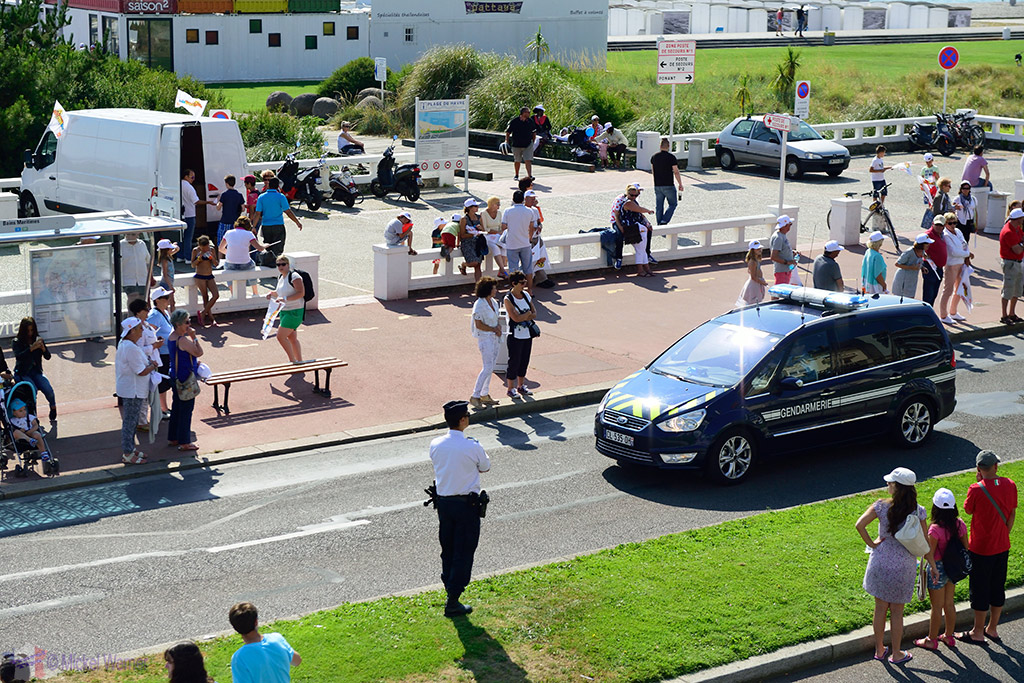
We’re now getting close when the police security van arrives.
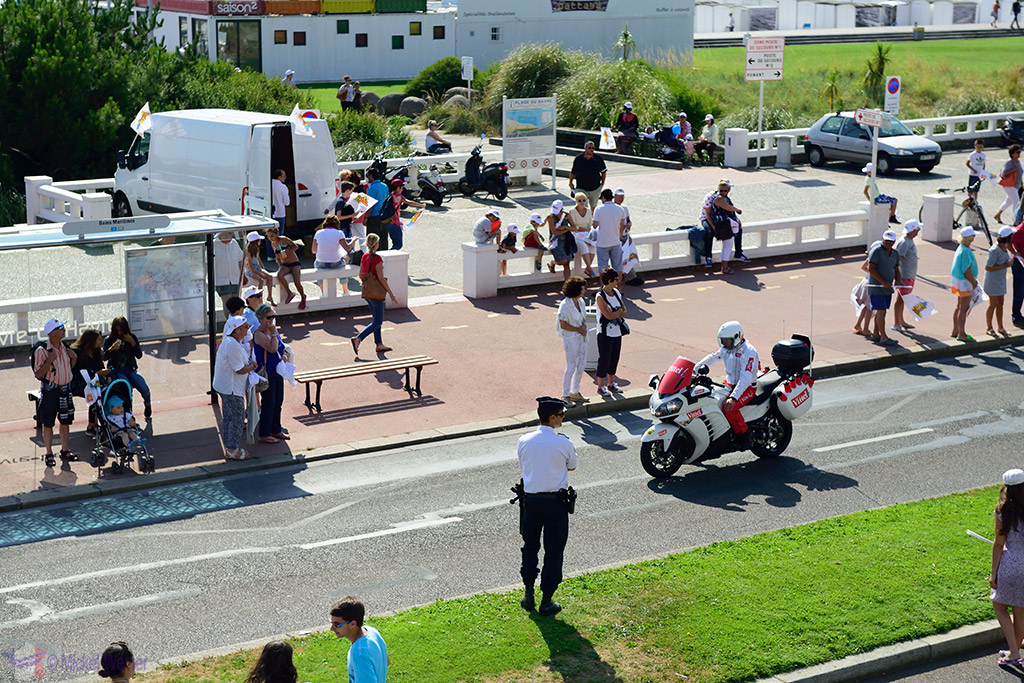
This (Kawasaki) motorcycle carries water for the cyclists. It’s for those cyclists who have not been able to get to their official team supplies, which often happens with breakaway cyclists.
And then you get the one sign that the race is very very close….
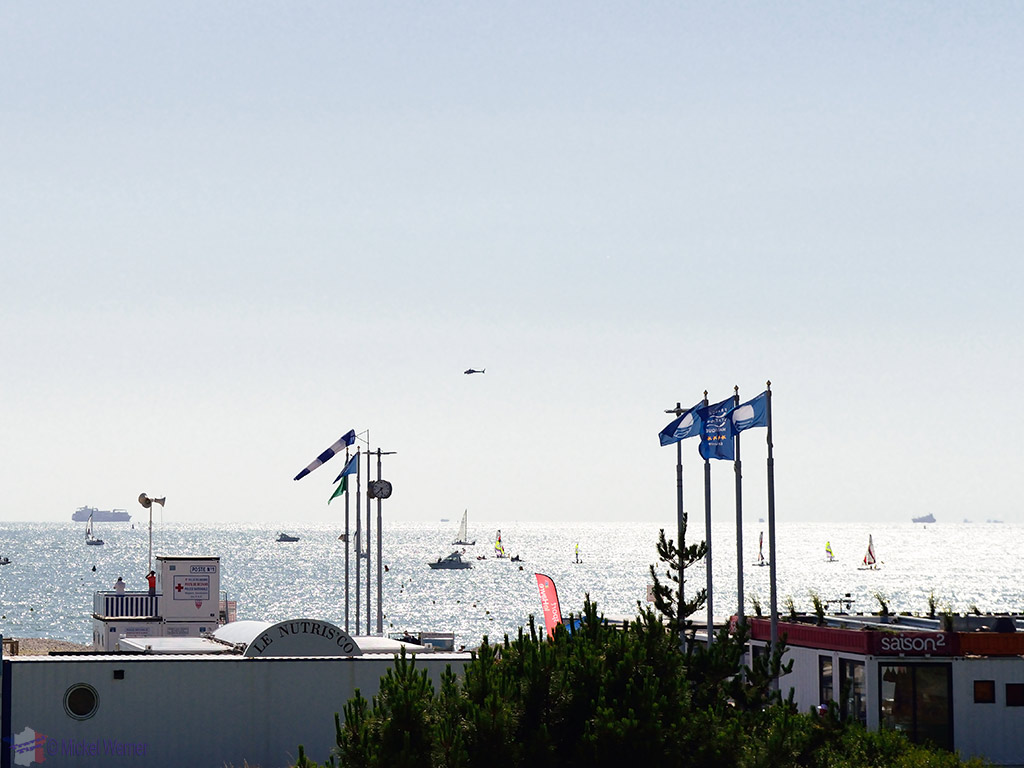
The first of five TV helicopters have arrived. The helicopters follow the race really close, so you know it’s about to happen.
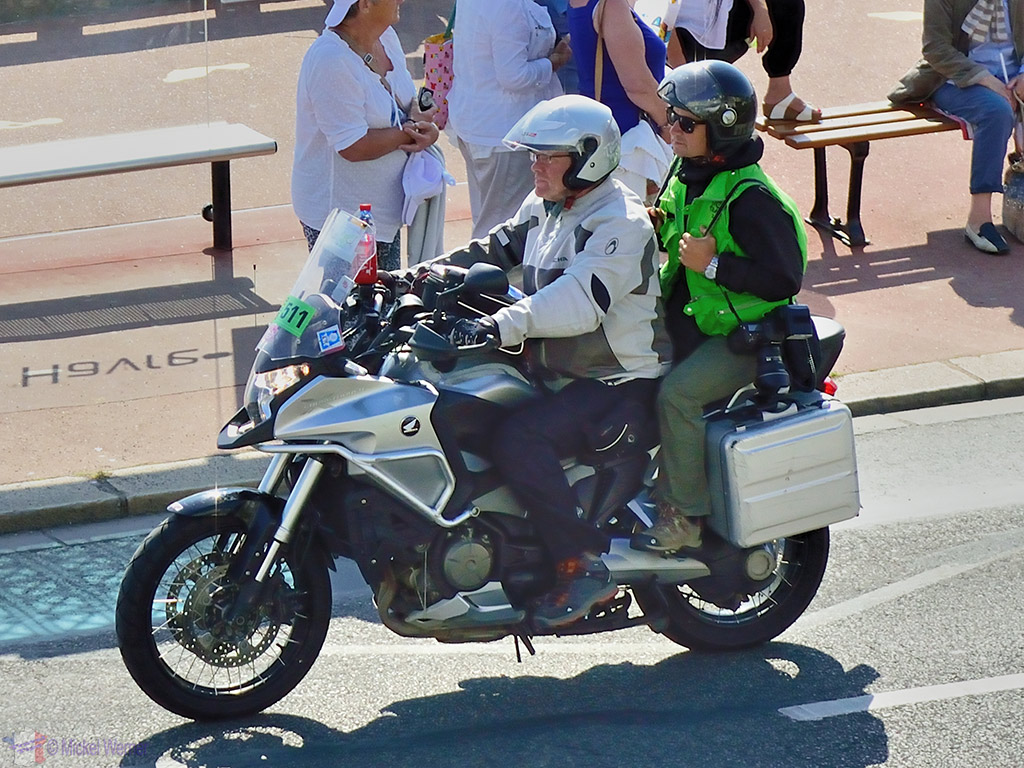
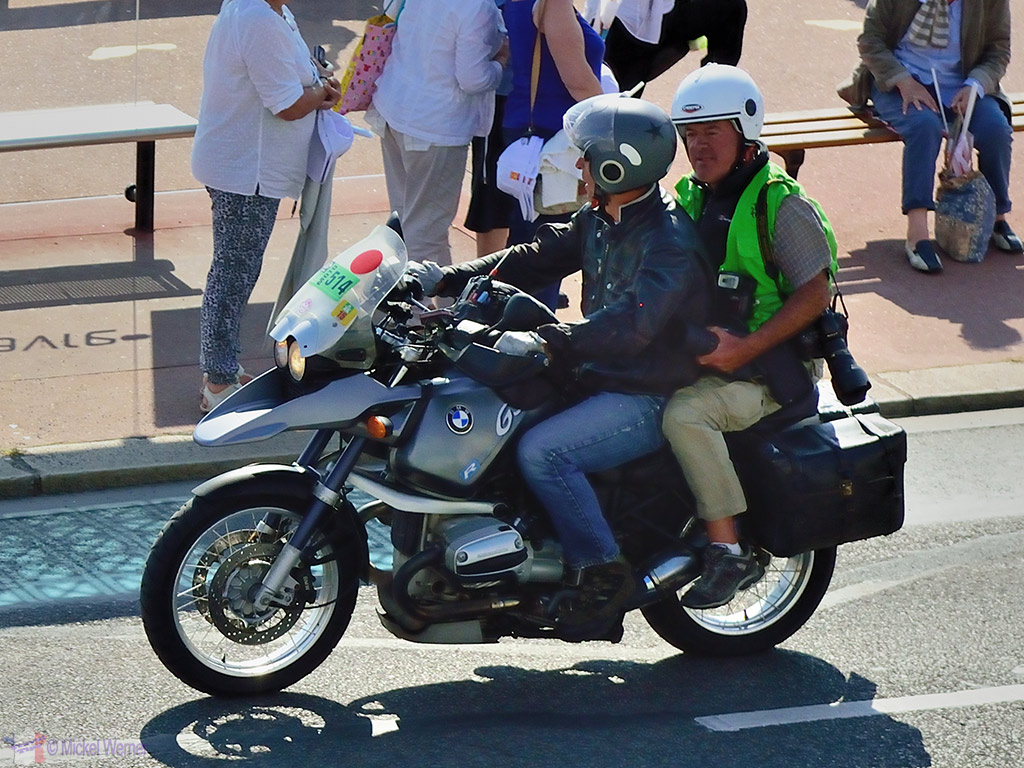
Many motorcycles arrive with photographers sprinting to the finish line (which is close to where I was standing). I estimate about 20 of them.
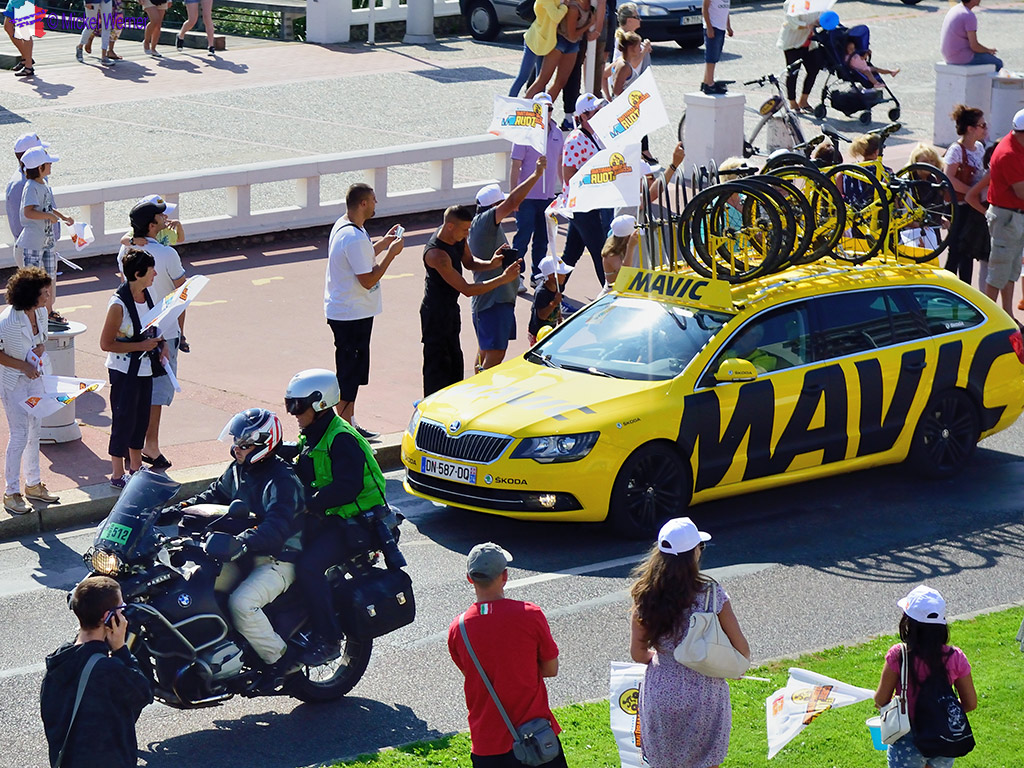
The first cars carrying the team’s spare bicycles arrive.
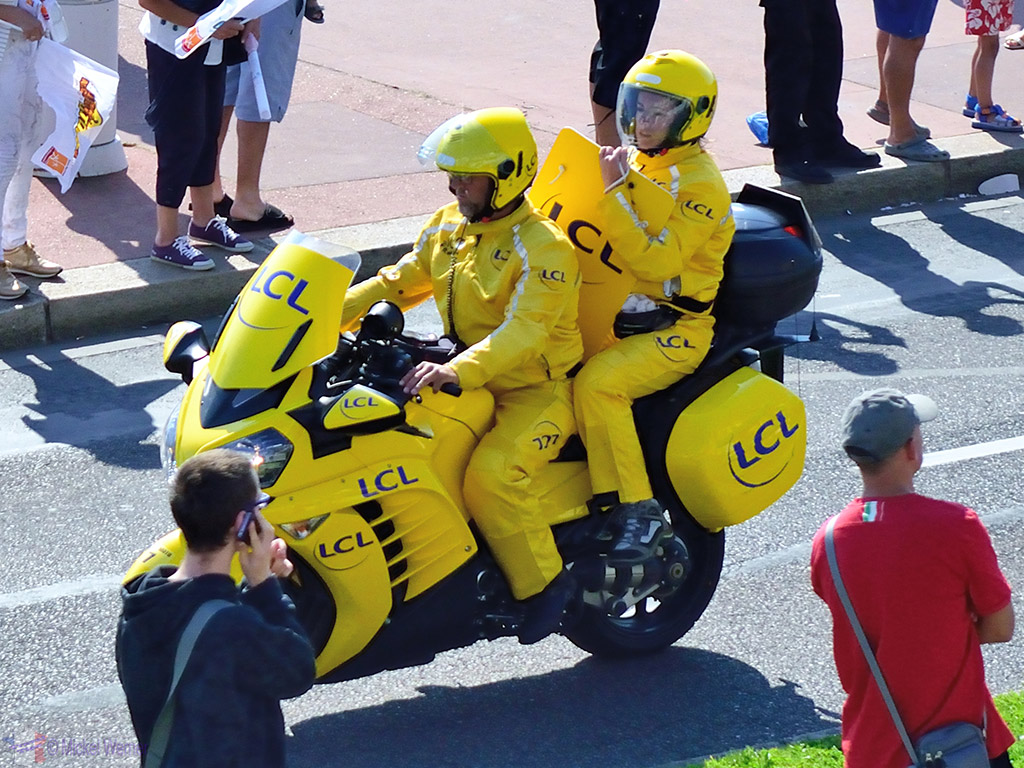
This is the time displayer, who rides in front of the breakaway cyclists showing them the time they are ahead of the main group. They are also on the official motorcycle of the tour.

One of several medical assistance motorcycles riding alongside wounded cyclists.
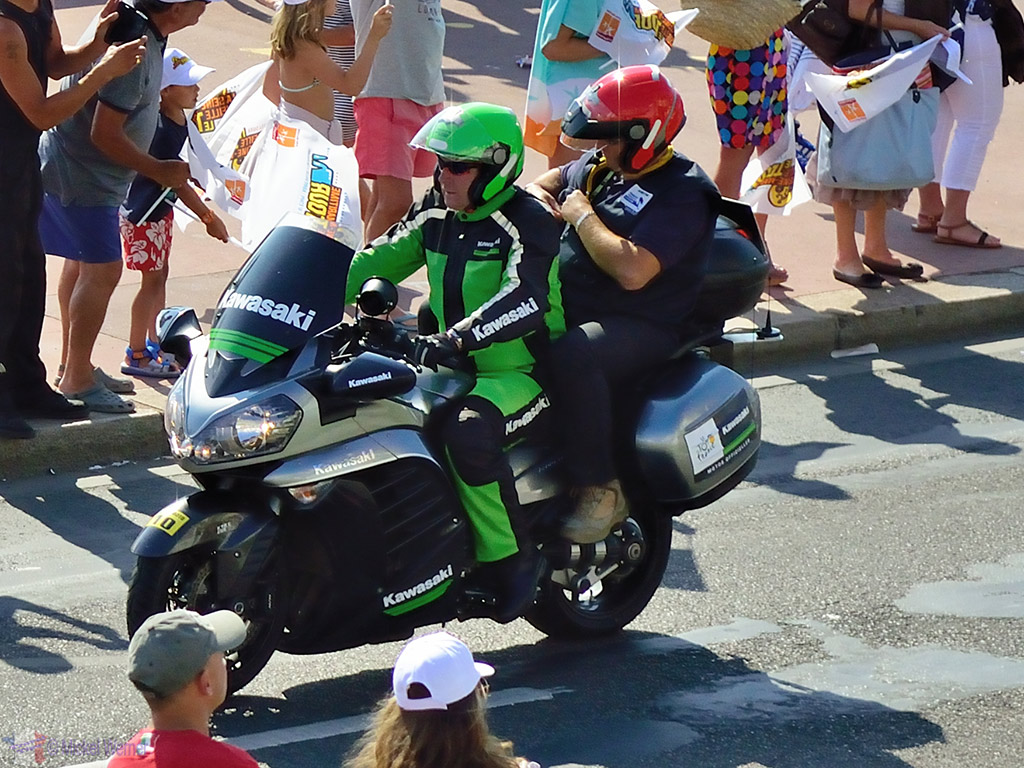

Some 20 press motorcycles arrive in advance of the first cyclists. And then …..
17:43

The first cyclist arrives, a breakaway cyclists, but the main pack is 10 seconds behind….
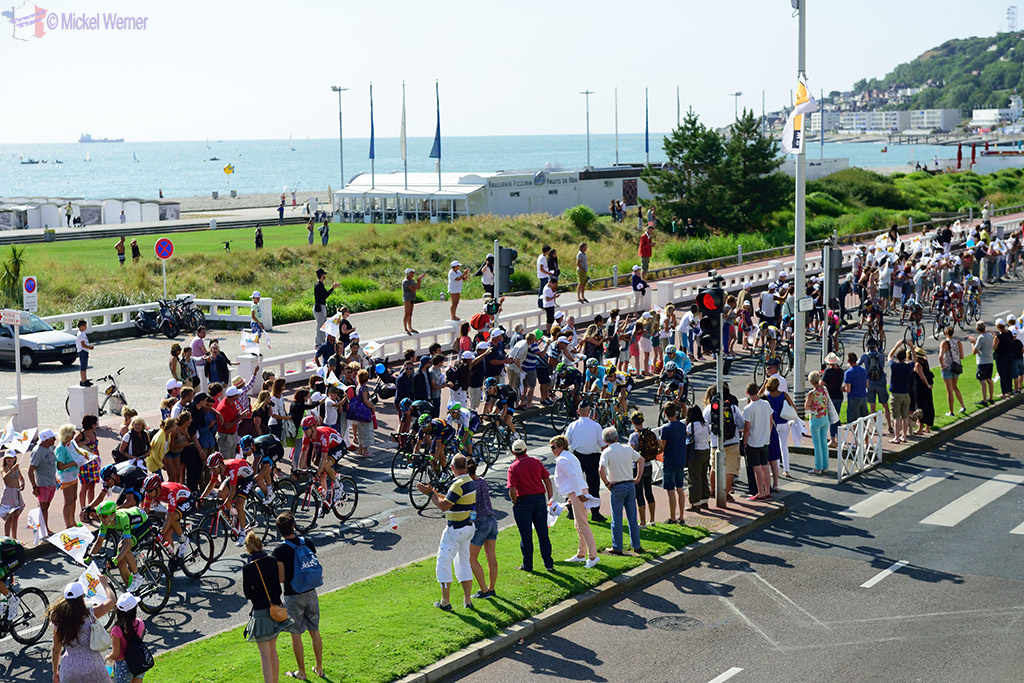
… and the breakaway cyclist is gobbled up by the main pack.
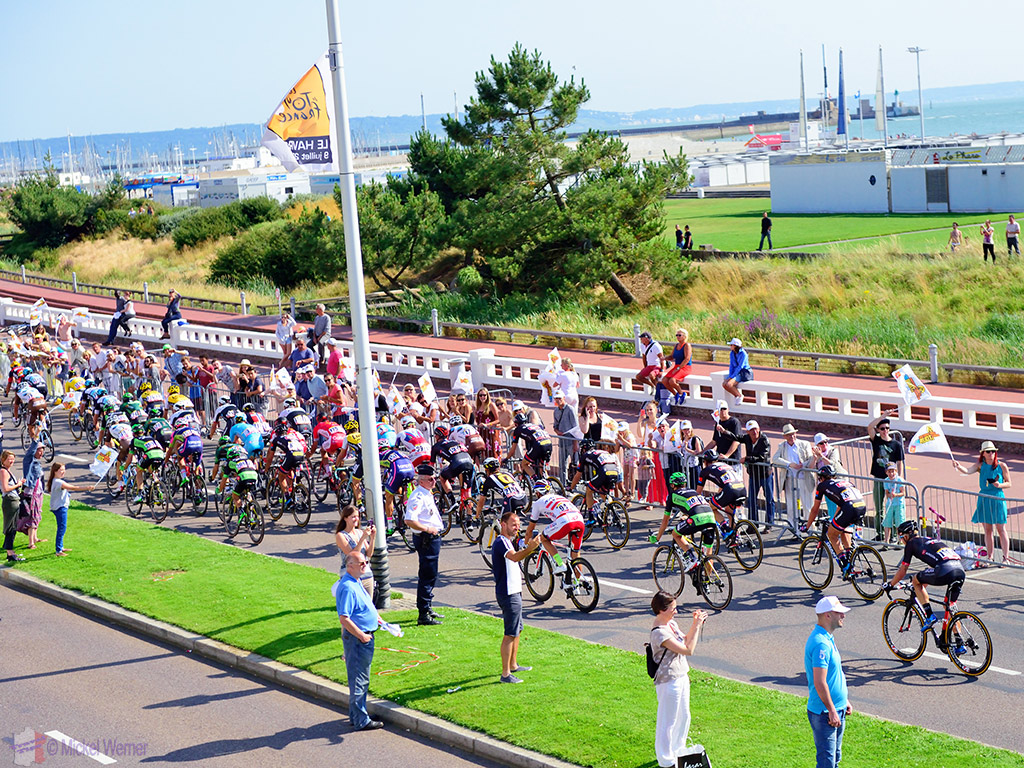
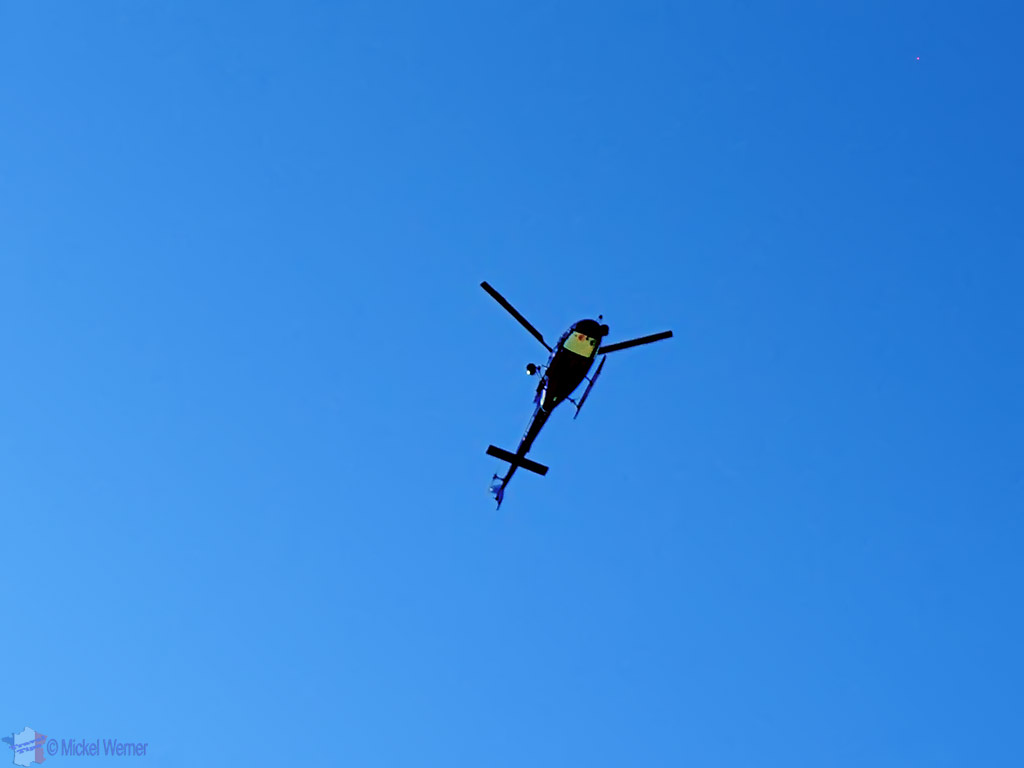
One of the 5 helicopters that follow and film the Tour.
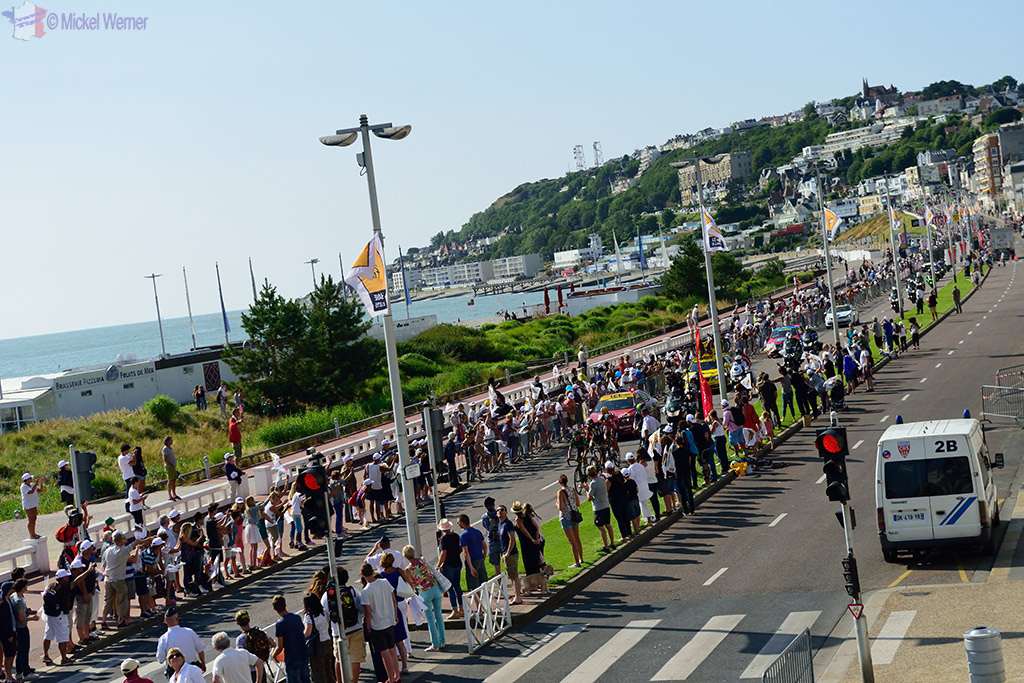
The last remaining cyclists come in at a slower pace. Their work has been done and then can take it easy.
17:43 + 40 seconds

The team support vehicles who follow the cyclists starting arriving, about 30 of them.

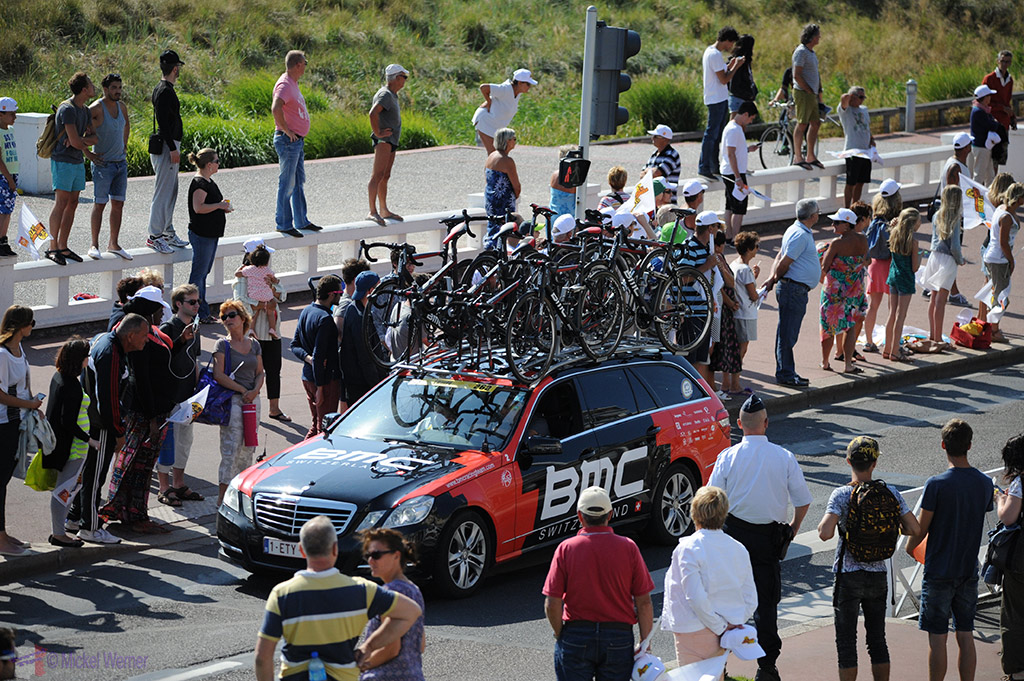

This is the Tour’s doctor who always drives in a convertible since it’s used to patch up the cyclists who have hurt themselves, and they are patched up while cycling (so on the move).
17:47
And the final vehicle of the Tour is:
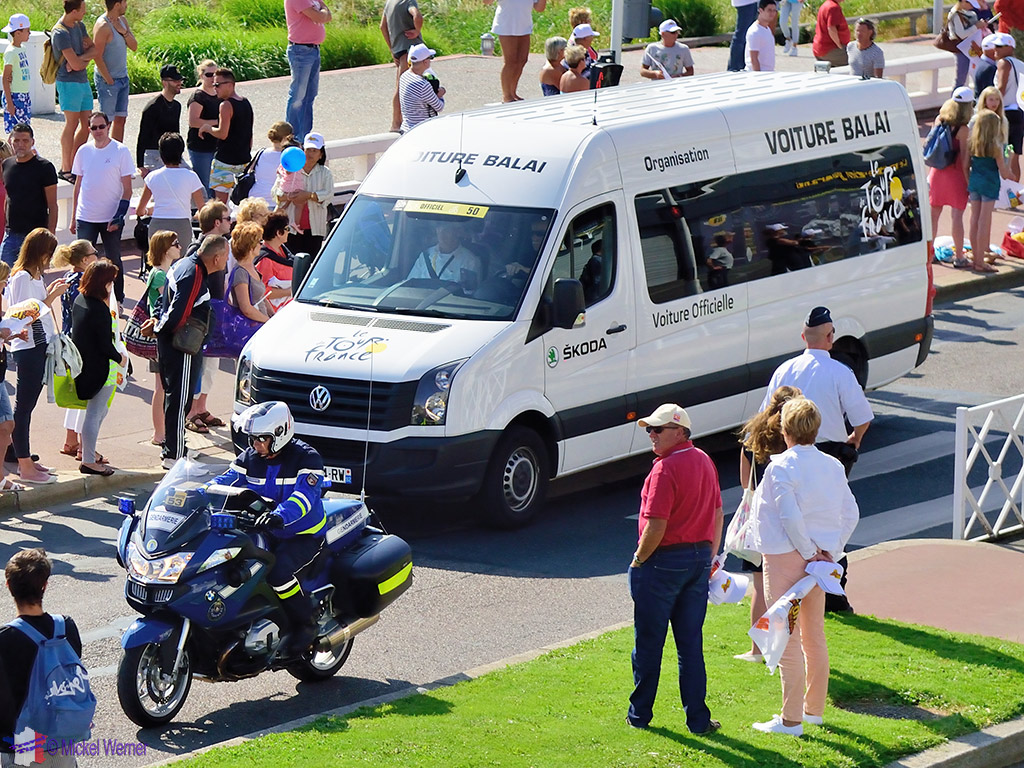
The sweeper bus, which picks up cyclists who have broken down.
And that ends the Tour de France. If you’re interested in following the Tour, you’ll need to head on out to the Tour’s official web site to see where they will be going, since it changes every year. The mountain portions (Alps and Pyrenees) are always the most popular and you’ll need to come very, very early to get a good spot. It’s better is to find a place somewhere along the 3 weeks where there are several tight curves but no mountains.
